#like i love these three archetype / tropes
Explore tagged Tumblr posts
Text
remember the king / the soldier / the poet archetype ? which one of them is your muse ?
#THE TOPS OF MY HEAD: the kings are probs deku (surprisingly i know).... all might for sure...#the soldiers are sai DEFINITELY...#and while i think s.akura wants to badly be a soldier. shes.... totally a poet at heart. but physically i feel like shes more soldier#but at heart? my girl's totally a poet.#iruka is sooooooooo poet coded i cant even#and my other characters would probs be? like?? hanamichi is a king#usaida is poet. mumen rider is poet but also king coded. like he COULD be king i feel like#anyways. also. because im kinda fixated on him but -- deku is so soldier coded on the surface. BUT HE IS KING ARCHETYPE FOR SURE#like i love these three archetype / tropes#i could talk abt them everyday#and i'd LOVE to hear everyone's interpretation of it @ their characters#also if u don't know these archetypes -- feel free to check out ''Soldier Poet King'' by Oh Hellos!#theyre what triggered the whole new fictional archetype movement on social media for a while!#gen: out of character.
3 notes
·
View notes
Text
Understanding the Romantic Narrative Arcs in Final Fantasy VII
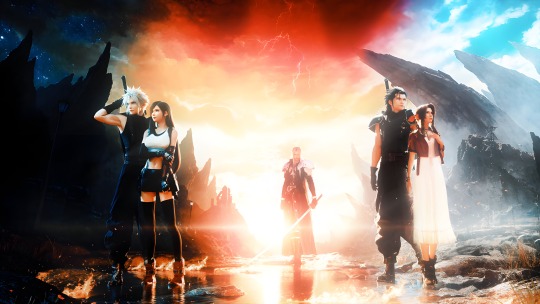
There has been no shortage of discourse surrounding the “Love Triangle Debate”, (a fan-constructed term, I must inform you) of FFVII for a very long time. Most recently, with the release of FFVII Rebirth, this discourse has intensified and led to a wide spectrum of fan conclusions that range from grounded in narrative sense to completely baseless or delusional. Some takes are attached to contemporary relationship issues, personal experience, comparisons to other media or works of fiction, social constructs or societal issues, personal preference, or a lack of full context.
While any piece of media or fiction is subject to some level of interpretation (this is the very nature of humans consuming works of art), most works are created with intentional narrative direction. In fact, many works are formulaic, especially in genres such as fantasy, romance, mystery, etc. While of course there are always exceptions and deviations, as a writer and former English literature teacher I can say that most stories follow a general narrative structure or arc that makes them digestible and satisfying to readers/audiences. Such arcs impact the main, external, internal, and subplots of a story, as well as individual character arcs and character relationship arcs.
Final Fantasy is no different. While there are other cultural influences as FFs are Japanese stories, my experience with the series is the writing generally follows most storytelling conventions that can be found in all forms of archetypal writing, cross-culturally and generationally. FFVII is often accused of being ambiguous or open-ended in many aspects of its story. I tend to disagree with this idea and think that its storytelling is subversive rather than ambiguous, meaning that it requires players to work harder and use more critical thinking in order to reach the author’s intended conclusions. It also relies on false or misleading narratives for a good part of the story (such as red herrings, illusions, or unreliable narrators) as storytelling devices that help the truth in the story unfold in later parts of the narrative arc(s). Like any piece of media using these storytelling methods, this means that there will be controversy or debate as audiences contend with the author’s messages or intentions. However, that does not mean that the intentions are not there and that there is not an intentional outcome on the part of the writers.
Personally, I believe that FFVII has a very clear narrative structure for all of its main plot, sub plots, and character arcs, but that its approach is challenging to many players who have to wrestle with the story as it unfolds to understand it. It is not spoon-fed, and some revelations may betray player attachments that were originally formed. However, in my view, this is what makes FFVII such an exceptional story when compared to many others. That being said, the lack (or refusal) of understanding of FFVII’s narrative arcs has led to discourse that unfortunately mischaracterizes many of the characters and pushes inappropriate perspectives onto the storytelling, mostly surrounding the romantic arcs of the main characters and the so-called “LTD” (the fan construction, remember?). I strongly believe that the best way to understand any story is to follow the narrative arcs in order to arrive at the author’s intended conclusions.
I’m going to attempt to do that for the romantic subplots in FFVII in hopes of bringing some clarity to this issue. This analysis is based on a standard Three-Act Romance narrative writing structure (which aligns with the Hero's Journey structure), as well common romantic archetypes and tropes, both for characters and plot, but applied to the specific context of the story, world, and characters of FFVII. Please note that this is my personal analysis and it is by no means perfect, nor am I saying this is the bible of how FFVII has been written. I just hope it gives some insight into why some storytelling interpretations of FFVII should make more sense than… others. This analysis will draw from bits of the entire compilation, but the primary focus of the structure will be looking at FF7R with the OG as a baseline.
This is a long thread, so please see the outline for discussion below.
Romantic Structure/Trope Analysis
Cloud/Tifa: The Slow Burn/Childhood Friends to Lovers Romance
Aerith/Cloud: The Unrequited Love/Not Meant to Be Romance
Zack/Aerith: The Long Lost Love Romance
Final Thoughts: The "Love Triangle" is a Narrative Illusion
Cloud/Tifa: The Slow Burn/Childhood Friends to Lovers Romance
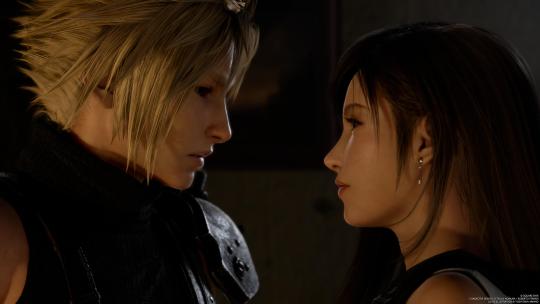
Act 1: The Beginning
The Hook (Childhood Connection Revealed)
Romance Structure: Introduction / Setup
Purpose: Establish the protagonists in their everyday lives, showing what emotional or psychological issues are holding them back from love. Readers should get a sense of their internal conflicts and motivations, along with the external situations that will challenge them later.
Childhood Friends Layer: Introduce the deep connection between the two characters, showing them as lifelong friends with an established bond. There could be hints of one or both characters secretly harboring feelings for the other, but they haven't acted on it due to fear of losing the friendship.
Example: Cloud and Tifa are childhood friends with a complicated history. Although they were close when they were little, they drifted apart but secretly longed for one another. They shared a romantic promise and then separated for seven years. At the beginning of FFVII, they are reunited, but both characters are contending with serious internal and external conflicts - Cloud’s identity crisis and the Shinra Company’s greed and abuse of the planet.
The Inciting Incident / Call to Adventure / Meet-Cute
Romance Structure: Inciting Incident / The Meet-Cute
Purpose: The main characters meet or are pushed together by external circumstances. This encounter introduces the romantic conflict—whether it’s instant attraction or tension between them.
Childhood Friends Layer: Since they’ve already known each other for years, the “meet-cute” here is more about seeing each other in a new light. Maybe one of them returns to town after time away, or an external event shifts their dynamic, making one or both start to view the other differently.
Example: Cloud and Tifa reunite in Midgar and Tifa recruits Cloud to work for AVALANCHE. She does this primarily to keep him close so she can keep an eye on him as she is worried about him and his mental state. During this time, we see an instant chemistry between Cloud and Tifa as they reconnect after years apart. When conflicts are introduced, we see the strain that it puts on them, but we also see how there’s a lingering desire for closeness, whether it be in their discussion/memory of the promise, their mutual flirting, their skinship, etc.

First Plot Point / Refusal of the Call
Romance Structure: Rejection of the Relationship
Purpose: The characters resist the idea of a romantic relationship, often due to internal or external obstacles. There’s a clear push-pull dynamic as they fight their growing attraction, often rejecting the possibility of being together.
Childhood Friends Layer: The hesitation here comes from their shared history. Both characters are afraid to risk their close friendship for something as uncertain as a romance. This dynamic creates tension as they begin to realize how much they depend on each other emotionally.
Example: This isn’t directly addressed, but the narrative deflects from intentional romantic confrontations at this point because of Cloud’s identity crisis and the pressing issues of the external conflict. Neither character is outwardly pursuing a relationship, but they don’t exactly deny their desire for closeness. We consistently see the push/pull between Cloud and Tifa throughout the early part of their arc. It's also further complicated when Sephiroth starts to sabotage their relationship.

Act 2: The Middle
First Pinch Point / Acceptance of the Quest
Romance Structure: Giving the Relationship a Chance
Purpose: External circumstances push them together, forcing them to interact and face their growing connection. Even if they resist the idea of love, the bond between them deepens as they spend more time together.
Childhood Friends Layer: Their shared history becomes an advantage and a source of conflict. The deeper they dive into new romantic feelings, the more they rely on the comfort of their friendship, but they’re also terrified of crossing the line and ruining everything.
Example: Cloud and Tifa work together both with AVALANCHE and the party at large to combat the threats present in the external conflict. Additionally, they share deep trauma from the Nibelheim Incident that brings them closer together as sources of comfort. They become one another’s rocks, and though they still do not move toward any explicit romantic confirmation, it is clear from their behavior that they both hold deep feelings for each other and care for each other greatly. Cloud in particular holds on to his promise to Tifa, making it a cornerstone of his strength moving forward.

Midpoint Crisis / Trials and Temptations
Romance Structure: Midpoint / I-Need-You-But-Can’t-Have-You
Purpose: This is a major turning point where the characters either experience a "false high" (where they feel like things are going well but something still isn’t quite right) or a "false low" (where they feel like things are falling apart). There’s often a pivotal moment of intimacy that deepens their bond but also introduces new fears.
Childhood Friends Layer: The fear of losing the friendship intensifies. They might experience their first kiss or confession of deeper feelings, but the risk of ruining their long-established bond makes the situation more fraught with anxiety.
Example: This particular point in the arc gets a little tricky for Cloud and Tifa because of Cloud’s identity crisis and Tifa’s reticence around their mismatched issues. However, Rebirth has made it clear that before the end of disc 1, Cloud and Tifa are aware of their feelings for each other and that the narrative is still in the way of it. This arc intersects events that transpire from Kalm to Gongaga, and we see the build-up of tension due to the internal conflict between Cloud and Sephiroth.

Second Pinch Point / The Road Back
Romance Structure: Pulling Back Together
Purpose: The characters are drawn back together by external events, but their internal fears and conflicts still loom large. The romance starts to deepen, but both are still fighting their feelings in some way.
Childhood Friends Layer: They try to go back to being "just friends," but it’s clear that things have changed between them. The emotional and romantic tension keeps building, and they can’t ignore how much they need each other.
Example: We see this dynamic between Cloud and Tifa continue to build throughout disc 1, particularly in Rebirth. We are consistently reminded of the tension between them and the importance of their relationship, regardless of romantic intent. Gongaga and Nibelheim are great examples of this.
Second Plot Point / The Fall
Romance Structure: The Fall
Purpose: The characters are now falling in love, even if they haven’t fully admitted it to each other. There’s often a deeper moment of intimacy—physical or emotional—that makes them realize just how much they mean to each other.
Childhood Friends Layer: One or both characters realize they’ve fallen hard for their best friend, but they are still careful or hold back from telling the other, afraid it might ruin everything. Nonetheless, they give in to their feelings in some capacity, which marks a turning point.
Example: The Gold Saucer date would be the best parallel for this point in the arc for Cloud and Tifa. In the OG Tifa almost confesses to a very interested Cloud, in Rebirth, they confirm feelings and kiss. Either way, it’s clearly meant to signal at this point, the fall has happened.

Act 3: The End
The Crisis / Dark Moment
Romance Structure: Dark Moment / The Break-Up
Purpose: This is the point where everything falls apart. The characters break up or distance themselves, either because of internal or external forces.
Childhood Friends Layer: The weight of their shared history makes this moment even more devastating. The fear of losing the friendship forever becomes real.
Example: For Cloud and Tifa, this moment is really hinged on Cloud’s mental breakdown. After the Gold Saucer Date, Cloud’s mental state progressively worsens due to events that occur within both the internal and external conflicts, and his bond with Tifa is severed completely at the Northern Crater. Cloud and Tifa are separated when Cloud falls into the Lifestream.

The Sacrifice / The Crisis Resolution
Romance Structure: The Sacrifice
Purpose: One or both characters must confront their fears and make a choice. This moment often involves a grand gesture or a realization that love is worth the risk.
Childhood Friends Layer: The realization comes that their friendship has always been the foundation of something more. They understand that risking the friendship for love is not only worth it but that the friendship can only deepen through their romantic connection.
Example: This point comes in Mideel and the Lifestream Scene. Tifa reaches her own realization about her relationship with Cloud and how her reticence has impacted things, and her conviction to save him and be with him is both profound and clearly romantic. Inside the Lifestream, Tifa helps Cloud to find himself, and many revelations about his true feelings for her are brought to light. Of course, we have not reached this point of the story in FF7R, so it will be intriguing to see how it unfolds, given all of the additional context the remake series and ToTP have provided.

The Climax / Declaration
Romance Structure: Declaration
Purpose: The characters finally confess their love for each other, making the leap from friends to lovers. This is the emotional high point where the relationship is solidified.
Childhood Friends Layer: The confession of love is tied to their long history, as they realize that their deep emotional connection as friends is the foundation for a strong romantic relationship.
Example: This moment for Cloud and Tifa is the Highwind Scene in the OG, where they confirm, without words, that their feelings match. Once again, we will see how this event unfolds in Part 3 with all the new and deepened context of Cloud and Tifa’s relationship in 7R.

The Resolution / Denouement
Romance Structure: Denouement / HEA
Purpose: The characters are together and happy, giving the reader a sense of closure.
Childhood Friends Layer: The resolution emphasizes how their strong friendship has transitioned seamlessly into a romantic relationship, giving the sense that they’ll continue to support each other as both friends and lovers.
Example: In the OG, this is seen in the FMV of the game where Cloud and Tifa are together, leading to the resolution of the entire story as Holy and the Lifestream are released. While this scene isn’t particularly direct, it’s enough to show that Cloud and Tifa are together, which leads to ACC where they live and raise a family together. This entire ending segment will likely be greatly expanded in FF7R, and so it'll be interesting to see how these moments are handled, given all of the new context.
Aerith/Cloud: Unrequited Love/Not Meant to Be Arc

Act 1: The Beginning
The Hook (Unrequited Feelings Introduced)
Romance Structure: Introduction / Setup
Purpose: Introduce the protagonist, who falls for the other character. Set up their emotional and psychological conflict, showing how these unrequited feelings shape their interactions with the other character.
Unrequited Love Layer: The character’s love is clearly unreturned, but they hold on to hope. There is a mix of admiration, longing, and pain as they watch the love interest live their life without ever seeing them as a romantic partner.
Example: Aerith’s feelings for Cloud, who she meets first on the streets of Midgar and later inside her church, are inspired by her long-lost love, Zack, whom he reminds her of. We don’t know this immediately, but we find out soon enough, and the story, especially 7R, is full of visual and symbolic cues.
The Inciting Incident / Call to Adventure / Meet-Cute
Romance Structure: Inciting Incident / The Meet-Cute
Purpose: The characters are pushed together by external circumstances, giving the protagonist more time with the love interest. The character sees this as an opportunity to grow closer, but the other character remains unaware or indifferent to their romantic feelings.
Unrequited Love Layer: The character is thrilled to spend more time with the other character and hopes this will bring them closer. However, the love interest still sees the relationship as platonic, creating tension.
Example: While their interaction on Loveless Street is the fated moment for Cloud and Aerith, the meet-cute is their meeting in the church. This is the inciting incident that not only truly triggers Aerith’s latent Zack-longing, but also begins Cloud and Aerith’s friendship as they work together for a common cause. Aerith flirts with Cloud quite a bit at this point, displaying her interest, but Cloud does not reciprocate in any romantic sense. She also refuses to let him leave and follows him around, essentially solidifying Aerith’s place in the player party and cementing her role as the heroine driving the external conflict. From here on out, we are consistently reminded that Cloud reminds Aerith of Zack, the deeper reason for her interest in him.
First Plot Point / Refusal of the Call
Romance Structure: Rejection of the Relationship
Purpose: The protagonist’s feelings remain unrequited. The other character might express interest in someone else or explicitly state that they don’t see the protagonist in a romantic light. This deepens the emotional conflict for the protagonist, who struggles with unspoken feelings.
Unrequited Love Layer: The protagonist is heartbroken but holds onto hope. They keep pushing their emotions down, unwilling to let go just yet.
Example: Aerith meets Tifa and quickly realizes that she is someone deeply important to Cloud. In Remake, she realizes this even before meeting her when Cloud has a headache and calls out Tifa’s name. Her awareness changes her behavior somewhat, but internally, she still is still conflicted because of her internal conflict over Zack.
Act 2: The Middle
First Pinch Point / Acceptance of the Quest
Romance Structure: Giving the Relationship a Chance
Purpose: External circumstances continue to push the characters together, and the protagonist’s feelings deepen. They begin to cling to small moments, hoping that their love might one day be reciprocated.
Unrequited Love Layer: The protagonist interprets friendly gestures as signs of romantic potential. They invest emotionally in every small interaction, hoping it means more than it does. However, deep down, they start to feel the weight of their unreturned affection.
Example: The journey continues with the party leaving Midgar, and Aerith’s feelings for Cloud grow despite her knowledge of his bond with Tifa as the party travels together. In Rebirth this is further complicated by Aerith’s loss of foresight/memories to the Whispers. We are also constantly reminded of Aerith’s lingering feelings for Zack and her grief and sadness over his loss/disappearance. Throughout the journey, she seeks out opportunities to spend time with Cloud - “dates” even though these moments are not reciprocated romantically. A notable example of this is her date with him on the clock tower in Kalm, where she speaks to him about his relationship with Tifa (hinting at her knowledge of their bond and her jealousy over it) and then her public declaration that they were on a date (in front of Tifa). Cloud's reaction to moments like these continue to inform the audience he does not return romantic affections for Aerith.
Midpoint Crisis / Trials and Temptations
Romance Structure: Midpoint / I-Need-You-But-Can’t-Have-You
Purpose: A major turning point occurs where the protagonist either faces the possibility that their love will never be returned or sees a fleeting moment where they think it might be. The emotional stakes are higher, as the protagonist grapples with whether to continue holding on.
Unrequited Love Layer: The character might attempt to make their feelings known, either explicitly or through subtle gestures, but the love interest doesn’t reciprocate. The character is left feeling exposed and vulnerable, yet still holding on to hope that things might change.
Example: For Cloud and Aerith, this continues to be the nature of their relational development throughout most of disc 1, but their interaction on the water tower in Nibelheim is probably the best example of this. Aerith has to grapple with her jealousy over Cloud and Tifa’s bond, which she has been observing for the entire game. Her acknowledgment of her feelings over it is a major turning point as a character. Additionally, this moment really cements that Cloud views his relationship with Aerith as a cherished friendship, as we see the way that he cares about her angry reaction.

Second Pinch Point / The Road Back
Romance Structure: Pulling Back Together
Purpose: Circumstances force the characters to spend more time together, even though the character is starting to feel the emotional strain of unrequited love. There may be a moment of temporary hope, but it’s tinged with the growing realization that their feelings might never be returned.
Unrequited Love Layer: The character becomes more emotionally drained as they begin to sense that their love will remain one-sided. They might try one last time to be closer to the love interest, but the gap between them is becoming clearer.
Example: This moment could best be viewed through Cloud and Aerith’s Gold Saucer date. There, Aerith not only tries to get closer to Cloud but she opens up emotionally and gives Cloud insight into the root of her feelings, which is Zack. Cloud does not reciprocate any of Aerith’s romantic overtures in this date and rather displays discomfort or awkwardness throughout most of it. However, he does allow her a moment of emotional vulnerability, which he has not been willing to do previously. This is further contextualized by how, In Rebirth, Cloud has remembered Zack by this point (albeit incorrectly). Cloud, who cherishes and cares for Aerith greatly as a friend, is considerate of this connection and offers her comfort for the grief and loss she has just admitted to feeling and seeking consolation in him from. Hence "just until the ride's over"; "I didn't do anything" etc...

Second Plot Point / The Fall
Romance Structure: The Fall
Purpose: The character finally realizes that their love will never be returned. This is an emotionally intense moment where they are forced to confront the truth—they will never be more than a friend or confidant to the love interest.
Unrequited Love Layer: The protagonist may be devastated by the final confirmation that their feelings will never be returned. The emotional weight of unrequited love becomes too much, and they start to realize they need to let go, or come to other realizations about their feelings.
Example: The moment that most closely matches with this point in the arc is the dream stroll through Sector 5. Not only does Aerith accept that Cloud doesn’t return her feelings romantically, but she comes to a realization of her own feelings and questions them. This is clearly a reference to Zack, whose internal conflict has been consistently foreshadowed. Aerith also seems to recognize that she can’t help Cloud with his internal conflict - that is Tifa's role.

Act 3: The End
The Crisis / Dark Moment
Romance Structure: Dark Moment / The Break-Up
Purpose: This is the point of emotional reckoning, where they face the reality of unrequited love and move on in their arc.
Unrequited Love Layer: The character experiences grief over their unreturned feelings. They might decide to pull away from the love interest entirely, or they may try to come to terms with remaining friends while letting go of their romantic hopes and moving on.
Example: For Aerith, this moment is marked by her complete transition to her role in the external conflict. At this point, she has let go of her romantic fancy for Cloud and has committed herself to the bigger picture. It is at this point that she leaves the party, and leaves Cloud in the Sleeping Forest, to fulfill her role as a Cetra.

The Sacrifice / The Crisis Resolution
Romance Structure: The Sacrifice
Purpose: The protagonist sacrifices their unrequited love, realizing they need to move on for the sake of their own emotional well-being or greater purposes. This is a bittersweet moment of acceptance and self-growth, where they let go of the hope that kept them holding on for so long.
Unrequited Love Layer: The protagonist may realize that holding on to unrequited love is only hurting them or preventing them from reaching a greater purpose.
Example: For Aerith, this point in the arc is less about Cloud and more about her role in the external conflict. This is the point in which she travels to the Forgotten City, prays, and ultimately is killed. However, it is bittersweet and tragic for her, ultimately, because she dies with unrequited love from Cloud and without ever getting closure on her true love, Zack.

The Climax / Declaration
Romance Structure: Declaration
Purpose: Instead of a declaration of mutual love, this is the protagonist’s internal declaration of acceptance. They start the process of moving on.
Unrequited Love Layer: The protagonist lets go of the love interest in their heart, realizing that they need to focus on their own future. The love interest is likely unaware of this internal shift, but it’s a powerful moment of growth for the protagonist.
Example: For Aerith, this is perhaps best viewed in her complete transition after death to the larger role she plays as the heroine of the planet from within the Lifestream. Her arc has fully transitioned away from her feelings for Cloud into her greater purpose. In FF7R, we can hope to see how Zack, who has been trying to find her, begins to impact this next phase of her arc.
The Resolution / Denouement
Romance Structure: Denouement / HEA
Purpose: Instead of a traditional happy ending, this is a reflective, bittersweet resolution. The character has grown emotionally. There is a sense of closure, though it may come with lingering heartache.
Unrequited Love Layer: The character has let go of the hope that their love would ever be returned. They are stronger for it and have moved on.
Example: For Aerith and Cloud, this moment is best summed up by their brief Lifestream reunion at the end of the game. It will be intriguing to see how this moment is expanded and provides closure for Cloud and Aerith’s relationship, as well as Zack’s role in both.

Zack/Aerith: Long Lost Love/Tragic Love Arc

This arc is a little more complicated to map out since it is not only incomplete but riddled with mysteries at this point. However, I’m going to do my best to make the connections based on the information we have and where we can theorize things may be going.
Act 1: The Beginning
The Hook
Romance Structure: Introduction / Setup
Purpose: Establish the protagonist’s life after the estrangement, showing how unresolved feelings for their lost lover impact their emotional world. There’s a sense of longing and unfinished business that propels the protagonist’s actions.
Long Lost Lovers Layer: The protagonist is haunted by memories of their estranged lover and driven by a deep desire to find them again. This longing is fueled by unresolved emotional wounds, and the protagonist clings to the hope of a reunion.
Example: In Rebirth, from the beginning, Zack is singularly focused on reuniting with Aerith. After his escape from Nibelheim, even as he carries the wounded Cloud, Zack’s thoughts are consumed by Aerith. His love for her pushes him forward despite the dangerous and confusing circumstances he finds himself in. Zack’s motivation intensifies when he discovers, through a newscast, that Aerith is in danger. This revelation shifts Zack from hopeful longing to immediate action, driving home the urgency of his quest. His decision to prioritize Aerith’s safety over everything else, including Cloud, underscores how central Aerith is to his purpose, raising the stakes for his emotional journey.
The Inciting Incident
Romance Structure: The Call to Adventure
Purpose: The inciting incident transitions the protagonist from passive longing to active pursuit of reunion. Some event or revelation forces the protagonist to act, prompting them to seek out their estranged lover. Often, this is triggered by the discovery that the lover may be in danger.
Long Lost Lovers Layer: The protagonist realizes that simply hoping for a reunion isn’t enough—there’s now a tangible reason for urgency. This event serves as a catalyst for the protagonist to fully commit to the journey of reconnecting with their lover, increasing the stakes as they shift from passive longing to active pursuit.
Example: After mysteriously "surviving" his last stand against Shinra (as seen at the end of Crisis Core), Zack rescues Aerith from Shinra’s grasp in Rebirth. However, instead of a triumphant reunion, the moment is clouded with confusion and tragedy. This rescue scene signals Zack’s deep emotions for Aerith and heightens the sense of foreboding in their relationship arc. The player quickly realizes that the reunion isn’t straightforward and that darker forces are at play, casting a shadow over Zack’s determined rescue.
First Plot Point
Romance Structure: Refusal of the Call / First Obstacle
Purpose: The first major obstacle or refusal of the call introduces the initial challenges the protagonist faces in their pursuit of the lost lover. Despite their determination, external forces or internal doubts surface, complicating the journey.
Long Lost Lovers Layer: The protagonist’s optimism about reuniting with their estranged lover is challenged by harsh realities—whether through physical danger, supernatural elements, or emotional barriers. This moment introduces doubts about whether a reunion is possible, raising tension and uncertainty.
Example: Zack eventually brings a comatose Aerith and Cloud to Elmyra’s house. Zack’s devotion to them is evident as he cares for them despite their unresponsive states, but the world around him behaves in strange ways. The eerie sense of something deeply wrong in Sector 5 hints that Zack’s reality—and Aerith’s fate—are far from certain. He’s not just fighting to reunite with Aerith; he’s battling a reality that is becoming increasingly unstable. The player shares in Zack’s growing sense of anxiety and confusion, setting the tone for the more tragic layers of their arc to come.
First Pinch Point / Acceptance of the Quest
Romance Structure: Giving the Relationship a Chance
Purpose: The protagonist resolves to pursue their lost lover, hoping to rekindle what they once had. However, unresolved issues and emotional scars from the past begin to surface, complicating their journey.
Long Lost Lovers Layer: Time and distance have changed both characters, making reconnection difficult. The focus is on how time has altered both individuals and the lingering emotional weight of their separation.
Example: Zack’s attempt to reunite with Aerith is complicated by the metaphysical separation created by the Lifestream. Aerith remains comatose, as does Cloud, and Zack has to contend with both his own internal conflict as he tries to help them as well as the external conflict of his strange and mysterious circumstances within "Sector 5".

Midpoint Crisis / Trials and Temptations
Romance Structure: Midpoint / I-Need-You-But-Can’t-Have-You
Purpose: The protagonist’s need for their lost lover intensifies, but the relationship is far more complicated than expected. Old wounds and emotional or external barriers resurface, making reunion seem out of reach. Despite their determination, the protagonist begins to doubt whether they can ever restore what they once had.
Long Lost Lovers Layer: Time and emotional distance have changed the dynamics of their relationship. While both may care for each other, the past cannot easily be erased, and their attempts to reconnect are fraught with tension.
Example: External forces such as Sephiroth’s manipulations, and Aerith’s internal conflict over Cloud create an emotional barrier between her and Zack. Aerith, “asleep” in Zack’s world, remains unaware of his presence. As Zack learns from Marlene that Aerith’ "likes" Cloud, more tension and conflict is added. Despite these challenges, Zack remains unwavering in his commitment to reconnect with Aerith, determined to overcome the growing emotional distance.

Second Pinch Point / The Road Back
Romance Structure: Pulling Back Together
Purpose: The protagonist makes another push to reconnect with their lost lover despite significant setbacks. Faced with the reality that time is running out, the protagonist must act decisively to restore the relationship. While emotional connections may deepen, unresolved challenges threaten the outcome, leaving uncertainty in the air.
Long Lost Lovers Layer: Despite growing obstacles, the protagonist remains committed to rekindling the relationship. The emotional and physical distance between the lovers may still seem insurmountable, but the protagonist refuses to give up, holding onto the hope that they can salvage what they once had.
Example: Even as Zack’s hope begins to wane, he remains steadfast in his desire to reunite with Aerith. Zack finds himself pulled in multiple directions, creating additional conflicts. External forces and emotional entanglements continue to complicate their relationship, but Zack’s determination to bridge the emotional gap keeps pushing him forward. This section of Rebirth continues to heavily foreshadow both the truth about Zack as well as the future of Zack and Aerith's relationship, despite the conflicts.

Act 3: The End
The Crisis / Dark Moment
Romance Structure: The Break-Up / Darkest Hour
Purpose: The protagonist faces their darkest moment, where it seems that the reunion will never happen. Emotional scars or external forces tear the lovers apart, and the protagonist believes they’ve lost their final chance to reconnect. The relationship nears failure as the protagonist faces the harsh reality of their situation.
Long Lost Lovers Layer: The conflict grows to the point of no return. Previous mistakes or external conflicts surface, causing the relationship to fall apart, and the protagonist is left devastated, feeling that the reunion may never come.
Example: In Rebirth, this moment comes near the ending of the game when Sephiroth's confluence of worlds plays a role in role in further uprooting Zack's existence in the Lifestream. We also know that this is the time that Aerith dies in the real world, further complicating matters and adding new layers of conflict.

The Sacrifice / The Crisis Resolution
Romance Structure: The Sacrifice
Purpose: The protagonist realizes that to win back their lost lover, they must sacrifice their pride, fear, or ego. This emotional climax reflects their willingness to make a grand gesture or display vulnerability, showing they’ll do whatever it takes for a second chance.
Long Lost Lovers Layer: The protagonist makes a final, heartfelt plea to the estranged lover, acknowledging their mistakes and baring their soul. The lover, moved by the sincerity, must decide whether or not to take the risk of rekindling the relationship.
Example: Although we don’t yet know how this will play out in the Remake series, it’s likely that Part 3 will feature a reunion between Zack and Aerith. The conflicts that have built up—including Aerith’s internal struggle regarding Cloud—will need resolution. Advent Children (ACC) shows Zack and Aerith together in the Lifestream, setting the stage for a reunion in the Remake. The exact nature of this reunion remains speculative, but it’s likely Zack will make a significant sacrifice or grand gesture to resolve the emotional conflicts that have kept them apart.
The Climax / Declaration
Romance Structure: Declaration
Purpose: The estranged lover finally decides to take the risk and give the relationship another chance. After much internal struggle, they admit they’ve never stopped loving the protagonist, and they’re ready to move forward together. This is the emotional peak where both characters commit to each other.
Long Lost Lovers Layer: The reconciliation finally happens. After everything they’ve endured, the estranged lover acknowledges their lingering feelings and agrees to rebuild the relationship. Both characters take a leap of faith, trusting that they can overcome the past and move forward.
Example: Though speculative, if the arc follows the long lost lovers trope, Zack and Aerith will likely experience a heartfelt reunion in Part 3. Their lingering feelings would finally be acknowledged, clearing up Aerith’s complicated feelings for Cloud while reaffirming her bond with Zack. This declaration of love would also tie into the larger narrative arc, offering emotional resolution for both characters and allowing their story to move forward, especially in support of Aerith's role in the external conflict of the Planet.

The Resolution / Denouement
Romance Structure: Denouement / HEA
Purpose: The story concludes with a glimpse of the couple in their newly rekindled relationship. The emotional weight of their past has been lifted, and they are now ready to face the future together. Even if circumstances prevent a traditional “happy ending,” there is emotional closure and a sense of peace.
Long Lost Lovers Layer: After the pain, separation, and emotional struggle, the couple is finally together. The audience is left with a sense that their love will endure this time, offering a bittersweet but satisfying conclusion to their long journey.
Example: In Advent Children (ACC), we see Zack and Aerith reunited in the Lifestream, helping Cloud in his final battle. Their reunion suggests that, while they may no longer live in the physical world, their connection endures beyond death. Though bittersweet, their reunion offers emotional closure. The final installment of the Remake series will likely bring full resolution to Zack and Aerith’s arc, providing a satisfying conclusion, even if there are tragic elements along the way.

Final Thoughts: The Love Triangle is a Narrative Illusion
Cloud and Tifa’s Slow-Burn Childhood Friends to Lovers (Canon)
Cloud and Tifa’s relationship in Final Fantasy VII is a carefully crafted slow burn, rooted in a deep bond that extends back to their childhood in Nibelheim. Their connection is not built on superficial or flimsy romantic interactions but on a shared past and the quiet intimacy that grows from years of unspoken longing but is complicated by trauma.
Cloud and Tifa’s natural chemistry is driven by their subconscious desires and the deep, unspoken feelings they have for one another. For Cloud, his buried emotions instinctively reach out to Tifa, even though he isn’t fully aware of them. The narrative hides these true feelings, but subtle moments of affection and protectiveness reveal that, deep down, Cloud’s heart is already tied to hers, laying the groundwork for their eventual emotional connection.
The game’s emotional climax in the Lifestream, where Tifa helps Cloud piece together his shattered memories, is a pivotal moment in which both characters finally confront the depth of their feelings for each other. Their journey isn’t one of dramatic declarations, but rather a gradual, emotional reconnection that allows deeply held, mutual love and longing to blossom—a love that is grounded in shared history, healing, and mutual understanding and compassion.
This slow-burn romance stands as the true heart of Cloud’s emotional journey, dispelling the illusion of a love triangle and making it clear that Cloud’s deepest emotional ties are with Tifa.

Aerith and Cloud’s Unrequited Love / Not Meant to Be Semi-Canon/One-sided) (Fanon - mutual)
The dynamic between Aerith and Cloud, while often misinterpreted as romantic, is better understood through the lens of unrequited love and fate’s intervention. Aerith’s initial attraction to Cloud is undeniably influenced by his resemblance to her first love, Zack Fair.
As time goes on, Aerith tries to see Cloud for who he is, but tragically, this is not possible before her death, and her feelings remain complicated and unreciprocated. Their bond, while significant as friendship, never goes beyond that, reinforcing the fact that Aerith’s feelings for Cloud are more of an echo of her past with Zack.
Cloud's true self being in love with Tifa and Aerith’s tragic death seal the fate of their relationship as one that was never meant to be—a fleeting connection, shaped by circumstance rather than true compatibility.
The tragedy of this unfulfilled arc serves as a powerful narrative device, but it is clear that Cloud and Aerith were never destined to end up together, further dispelling the notion of a love triangle.
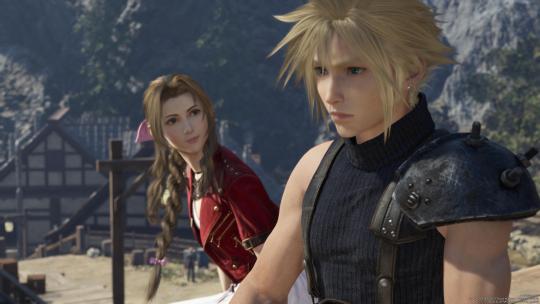
Zack and Aerith’s Long Lost Love / Tragic Love (Canon)
Zack and Aerith’s relationship is the quintessential tragic love story in Final Fantasy VII, defined by separation, longing, and loss. Aerith’s first love, Zack, vanishes from her life without explanation, leaving her with unanswered questions and unresolved feelings. Even as she begins to move forward, her heart never fully lets go of Zack, who is revealed to have fought valiantly to return to her—only to tragically lose his life in the process.
The tragedy of their love lies in the fact that both characters hold onto each other, but fate conspires to keep them apart, making their love story one of the most emotionally poignant elements in the game. Even in death, their connection endures, with Zack and Aerith appearing together in the Lifestream in ACC, symbolizing a love that transcends life itself. This arc, while bittersweet, resolves the narrative of Aerith’s romantic life—Zack was her true love, and Cloud was a reflection of the man she had lost, not a new love interest.
Their tragic love story dispels the myth of a love triangle in Final Fantasy VII, emphasizing that Aerith’s heart always belonged to Zack, even as she developed a bond with Cloud during her journey.
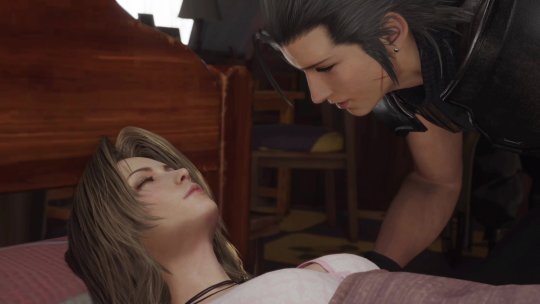
All of the relationships in the game are important. However, Cloud/Tifa & Zack/Aerith are the canon, mutual romantic relationships of Final Fantasy VII. Cloud/Aerith have a cherished friendship, but any romantic subtext of their relationship in the game is used as a vehicle to drive the conflicts and truths of the canon relationships forward. This is accomplished through illusions and subversions in storytelling, as well as creating internal conflict for the characters and canon relationships.
FFVII’s storytelling is deliberately designed to mislead the player through incomplete truths and emotional misdirection, including the use of red herrings, illusions, unreliable narration, and the omission of critical information or context. Cloud’s confused memories and persona, coupled with Aerith’s initial attraction to him based on his similarities to Zack, create the illusion of a romantic triangle, but the deeper truths—Cloud’s unresolved trauma and false identity, Tifa’s role as the keeper of Cloud’s real past and his true feelings, and Aerith’s ultimate fate as the Planet’s protector and her true love being Zack—gradually dismantle this illusionary love triangle.
I cannot stress enough that FFVII is not a love drama or soap opera where the game’s conflict centers on romantic rivalries, betrayal, deception, or morally questionable behaviors.. It’s a complex story that focuses on themes of life, loss, identity, self-discovery, legacy, and on and on.
Love - all kinds of love, including romantic, platonic, and familial - is a theme of FFVII, but truly and holistically, not for the sake of creating meaningless drama between the characters. The relationship dynamics appear messy at times in the earlier parts of the story, but these dynamics are designed to help us reach the proper conclusions about the story and the characters’ arcs, and how true love is a vehicle for reaching resolution for both.
Player’s choice is irrelevant to the plot. You cannot decide or alter the story structure or direction or individual character arcs or relationships. The most you can do is view the game through a slightly different lens by gaining an expanded understanding of character arcs and motivation with new replays.
Shipping is a fandom construct. It’s meant to be fun, and you can ship whatever you like. But shipping doesn’t intersect with the facts of a story or its narrative. Lying about any piece of media to convince yourself or others of its canonicity is bizarre behavior.
Respect the work and its intention, while having your shipping fun within your fandom. Don't embarrass yourself by saying an FF protagonist kissing the girl he’s loved since childhood and joined the army to impress means nothing, or worse, proves he the opposite of a hero.
You can ship your fanon without doing all that.
Last thing: Reunion is a primary theme of Final Fantasy VII. You may have noticed that it is also a primary theme for both of the canon romantic relationships. Personally, I believe that Part Three is going to drive this message home in a way that is unmistakable. I also believe that both lovers' reunions will be instrumental in resolving all of the conflicts of FFVII in the final game.
It’s not a coincidence that both reunions will take place in the Lifestream, or that they've been foreshadowed by the presence of the yellow flower.


I also believe that the dual Rebirth cover arts, described by Tetsuya Nomura as Sephiroth "tearing Cloud and Zack's worlds apart" are heavily foreshadowing the resolution of these relationships along with their connection to the the larger story structures of FFVII/FFVIIR.
Let's wait and see when Part 3 comes along.

#ffvii#cloud strife#cloti#tifa lockhart#final fantasy vii#ffviir#ffvii remake#ffvii rebirth#ltd#love triangle#love triangle debate#shipping discourse#shipping dynamics#shipping drama#shipping discussion#shipping debates
85 notes
·
View notes
Text
Okay, can I vent about a trend in Halsin fics for a moment? I notice this the most in Halstarion fics, but it seems to happen a lot in others as well. Like! I love y'all to bits, but we really need to stop with the trope of Halsin bringing up his enslavement to, say, Astarion, and this being IMMEDIATELY disclaimed with "that definitely isn't as bad as 200 years, but." We need to stop making their relationship a game of trauma olympics, and especially a game of trauma olympics where Halsin is ALWAYS the loser, always there to just to prop up Astarion's narrative/trauma. What is the point of saying "it wasn't as bad as yours?" Does Astarion lose anything at all if it isn't said that three years of slavery to a Drow matron mother isn't "as bad" as 200 years to a vampire?
And similar happens to other ships too! It just helps further this frustrating (to me) trend where even on the rare times when Halsin is acknowledged as something besides a therapist and comforter for other characters (which is a problem for almost every Halsin ship, for the record) there's still a deep need to make sure it's clear that his problems aren't ACTUALLY that bad, so no worries, he can still continue to dispense comfort to his partner!
It's just weird to me because I have never seen this kind of downplaying for any other character. Every other character has their trauma acknowledged in fics, but Halsin specifically... it's like people are allergic to validating his trauma. Is it because the allure of the archetype he fits when this is done (kind seme with no problems of his own) is more appealing than the reality?
Like, I'm just saying, I've never seen, say, a Halsin/Gale fic where Gale tells Halsin, "I know being infected with that orb was nowhere near as bad as being a sex slave, but." It only goes one way, with Halsin's trauma being underplayed compared to others.
And like! If it was just a point of characterization, of Halsin trying to ignore his own problems to focus on helping others, I'd get that too... if he was EVER called on it and told his trauma was 'enough', but that never happens!
(Please note that this isn't directed at any individual, either: if your fic happens to cast Halsin in a caretaker role, that's fine! I'm grumbling at the trend, not at any one particular individual whose fic might be part of it.)
59 notes
·
View notes
Text
On the subject of consent in recent BLs
In this analysis, I will take a look at several love scenes in recent Thai BLs, how they frame consent and the sexual agency of the characters, and why those matter.
(KinnPorsche deserves its own post: I’m sure people have already written in detail about how much emphasis is placed on issues of consent/non-consent throughout the show and how fundamental consent is to the relationship arcs of both KinnPorsche and VegasPete, and I won’t belabor the point here. Also, special shout-out to The Warp Effect for what it brought to the conversation about gay sex, but TWE isn’t technically a BL so I decided not to include it in this analysis.)
I am going to take a closer look at the following shows in this essay: Not Me, The Eclipse, A Boss And A Babe, Step By Step, and La Pluie.
Not Me and The Eclipse predate the other shows by two years/one year respectively, but I feel it is valuable to include them here because both show very explicit negotiations of consent that I feel are spiritual successors to the wonderful scenes we’ve been getting in the other three shows.
Why am I even writing this? There used to be an unfortunate tendency in the genre to have a power imbalance between the “seme” and the “uke” character, which translated into the seme deciding when to have sex and what kind of sex to have—and even though recently, several shows have done good work in dismantling the seme/uke dynamic and questioning the associated stereotypes, it cannot be denied that the archetypes are still an important part of most BLs, and even in cases where the tropes are played with and questioned, understanding those subversions still requires a knowledge of and familiarity with the original tropes on the part of the audience.
However, gone are the days of Until We Meet Again and Dean’s “I’ve waited long enough, make sure you’re ready.” (I enjoyed UWMA a lot but that was. Yeah. Not Great.) Now, we see characters actually talking about and negotiating their limits, and doing what feels good to them.
Let’s start from the very beginning. Not Me was an absolute trailblazer in this regard, and not mentioning it here would be a gross oversight. The first time Sean and White have sex, it happens in their version of the beach episode. (Which, in Not Me, is the two characters briefly living in a tent inside an abandoned building. This show is the best.) Sean and White are removed from their usual environment and protected from the outside world by two barriers: the walls of the old house and the tent that’s literally enveloping them and giving them a space that is unequivocally theirs, shared, in which neither one of the characters has any sort of power over the other. And what happens in that space when they’re about to have sex is extremely interesting: the first thing Sean asks is whether White is afraid of him, which White denies. The following exchange goes like this: White: "So, what are we doing?" Sean: "What should I do to you?" White: "That’s up to you." (Watch the whole scene here.)
I find this exchange incredibly meaningful because this already turns the seme/uke dynamic that can be found in a lot of other shows on its head. OffGun as a branded pair can easily be stereotyped into the seme/uke dynamic just because of their physical appearances, and clearly spelling out that both characters have agency in this scene is incredibly important.
And then it gets better! Sean assumes that White is sexually inexperienced (which is not true but the fact that White was actually in a relationship with a woman back in Russia never comes up again after the pilot episode, so maybe the show expects us to assume this, too), and suggests they try different things and White can tell him what he likes and doesn’t like. Compared to the stuff we’re getting now, this scene isn’t very high heat at all, but it’s one of my favorite intimate scenes ever because them asking each other “Do you like this?” after every kiss, every touch, is so incredibly unique and transports a wonderful sense of figuring out sexual pleasure together, as a couple.
Sex in Not Me is not something one character does to another, it is something that is discovered and shared together, and we even get an afterglow scene in which they gently tease each other about their fast beating hearts. (And don’t get me started on the importance of White choosing to ask Sean whether Sean is okay with White not being like Black in that moment right before they have sex, because he doesn’t actually want to have sex with Sean as Black! He wants to discover and share intimacy with Sean as White, as himself, not as his brother! The layers!)
Anyway, I think that scene paved the way for a lot of the conversations around consent we’re now getting in BL, just because it is so explicitly, unashamedly putting forward a definition of sexuality that has nothing to do with one character actively giving and the other passively receiving, but frames intimacy as something that is built together. (More on giving and receiving later!)
Now, moving on to The Eclipse. I decided to include the first time Akk and Aye have sex for a different reason: while we don’t really see them actually talking about consent, we see them practicing non-verbal consent. Let me explain. Akk’s and Aye’s whole thing is teasing each other. At first, Aye is usually the one doing the teasing, but Akk gets the hang of it towards the end of the show and teases his boyfriend right back. When they’re in Akk’s childhood bedroom together, Aye clearly alludes to the fact that he thought they might use this opportunity to have sex for the first time, which Akk pretends not to understand, all while alluding to it himself. I love this guy. (Watch the whole scene here.) Anyway, Akk says he wants to sleep, lies down and once again, tells Aye jokingly he just wants to sleep, clearly expecting Aye to do what other BL protagonists do at that point and not take no for an answer (sidenote: I HATE the “saying no as foreplay” trope with a passion and as far as I’m concerned it should die already).
However, Aye is not like other BL love interests, and he backs off. He stops touching Akk, lies down with his back to Akk, showing Akk that he takes him by his word: if Akk says he wants to sleep, Aye is going to let him do just that. So now, it’s on Akk to say that, no, that’s not what he meant, can Aye please come back to cuddle. And then Akk is the one to escalate from cuddling to kissing, which is extremely important: we know that Aye has been ready to have sex with Akk since forever, it’s Akk who’s been having hangups about intimacy this whole time.
They don’t put consent into so many words on this show, but Aye shows Akk that he respects his limits and that Akk only has to tell him he doesn’t want to do something and Aye will take him at his word.
So, these are, to me, two foundational scenes of establishing consent: one that shows consent as something that is established verbally, as an ongoing conversation, and one that shows consent as something that is established physically, by showing your partner that you respect their choices and limits by way of simply acting accordingly.
Now, let’s get into the fun part: scenes we got so far in 2023. I’m writing this post on the 13th of June, and I’m sure this year still has some great things in store for us, especially because Step By Step and La Pluie are both ongoing and neither of the main couples are actually together yet at time of writing. However, they’ve both already given us AMAZING scenes on the topic of consent, so I feel it is worthwhile to write about those already.
I want to start off by talking about A Boss And A Babe.
Let me just preface this by saying that the intimate scenes in ABAAB are some of my all time favorites in BL ever, because in them, sex is something that is just so normal. When Gun and Cher have sex, we don’t see them very passionate, excited, reluctant or wide-eyed innocent (which are some of the emotions traditionally associated with sex in BL). On the contrary, in every single scene that shows them being intimate, both characters are incredibly calm. They’re certainly happy to be with each other, but in a subdued way. Someone described their second intimate scene as them seeming like they’ve been married for a few years. They’re both just… incredibly normal about having sex with each other. It’s simply something they like to do together. It’s a part of their romance but it’s not more or less important than any other aspects of their lives.
And consent is at the very heart of it.
When Gun and Cher have their first time, we see Gun explicitly asking for consent two times: first, “Can I kiss you?”, then, “Can I do more?” The second one even comes with the promise that if Cher says no, Gun will immediately go to sleep without mentioning it again. And then it is on Cher to say yes, to pull Gun close and kiss him to show him that he is comfortable with taking things further. (In the show, these two questions were shown apart from each other, I cut together a version of the whole First Time Scene in its entirety, watch it here.)
Now, things get more interesting: the second intimate scene shows Cher initiating the encounter (watch the whole scene here). Cher pretty consistently falls into the uke category, both physically and as far as characterization is concerned, but he’s certainly not shy in the bedroom. And this time, he’s the one who asks for consent from Gun: Gun asks “You’re starting it?” and Cher’s response is “Can I?” Despite him being framed physically lower than Gun, basically at Gun’s mercy, he still seeks confirmation that Gun is okay with the way things are going. Not to overstate it, but to me, this feels revolutionary. Once again, we’re being shown that sex is something two people do together, as a shared activity, and that the “seme” character isn’t expected to just be up for it. He, too, has the right to say no.
On this show, sexual agency is taken extremely seriously, and it is clear that both Gun and Cher give each other space to decide what they’re comfortable doing. This is shown in non-intimate scenes as well: there are so many moments on ABAAB in which the characters negotiate physical touch and closeness, asking each other for hugs before actually hugging each other, Cher leaning on Gun’s shoulder in the car but not allowing Gun to touch him because that’s not what he’s comfortable with in that moment, and so on. (The only exception to this otherwise pretty consistent rule is the kiss in the car scene, which I’m still extremely confused about because it seems to go completely against Gun’s character. Who knows what happened there.)
Of course, the fact that so much emphasis is placed on negotiation and consent isn’t surprising on a show that has such obvious kink undertones and whose Our Skyy 2 entry basically consisted entirely of Dom/sub roleplay at work—I’m just saying, I think someone on the writing team is way into BDSM and knows all about the importance of enthusiastic consent from all parties involved, and I would like to send them flowers.
Step By Step hasn’t really reached the point where we can analyse the dynamic between the main couple (although we can take some educated guesses based on the interactions we’ve seen so far). However, last week’s episode had an extremely important scene between Pat and Put: Pat wanting to have sex with Put, then changing his mind mid make-out (watch the whole scene here). I really like the way this scene was done. No matter how shitty Put treats Pat at times, in this instance, he immediately understood and respected Pat’s change of mind without Pat even saying or explaining anything—at the end of the episode, Put says to Pat that Pat should tell Put when he feels ready to have sex. (We already know this will never happen because of course, Pat and Put are not endgame, but I do appreciate the sentiment.)
BLs rarely include a whole storyline in which the protagonist is in an actual, serious romantic relationship with someone other than his endgame love interest (hi Moonlight Chicken!), or if they do then just to up the angst factor. In this case, however, I feel that this scene raises our expectations for Jeng even further: if the guy who is definitely not a romantic match for Pat treats Pat with this much respect in the bedroom, then Jeng has to do at least that and then some. I do feel confident that Jeng won’t disappoint in this regard, but it’s fascinating to see a show frame this kind of respect as the absolute baseline minimum, with the endgame love interest expected to do even better.
Now, the one you’ve all been waiting for. The one that made me write this whole essay in the first place: La Pluie.
Oh boy. Where to start.
A week ago, we got an incredible make-out scene on Saengtai’s floor, which ended in Patts stopping the encounter because he could tell Tai wasn’t really comfortable taking things further—@bengiyo talked about that scene in detail here. And then, three days ago, La Pluie gave us the most unique, trope-defying, timeline-changing blowjob scene of all time, and I want to talk about it.
Tai and Patts are making out on their bed, Tai is not ready to go “all the way” and stops Patts from undressing him. We see a very realistic frustrated reaction from Patts, who nevertheless immediately stops and accepts Tai’s wishes—it is clear that Patts does not expect things to go any further at this point, and that he won’t pressure Tai into anything.
And then, Tai offers to blow him.
(Unfortunately, this show is only on iQiyi so I can't link to it, but you can get a good impression of the scene here.)
I mentioned the concepts of giving and receiving earlier: other people have said this more eloquently than me, but there is a tendency not only in BL but also in wider society to view sex in terms of giving and receiving, with a lot of expectations and stereotypes attached to the roles during different sexual acts. On other shows, that blowjob might be framed as a consolidation or an apology, something that the giver does out of a sense of obligation without enjoying it much. Not so on La Pluie! Tai is shown incredibly happy and satisfied afterwards, both when they’re sleeping next to each other, as well as on the morning after (see also @ginnymoonbeam's post about that here). Tai offered to blow Patts because he simply wanted to, not motivated by guilt or anything of that sort. And he genuinely enjoyed it! In the post I linked above, @bengiyo points out that La Pluie consistently centers queer desire, or more specifically in this case, male desire for a male body; much in the same way that the camera fucking loves Force’s body on ABAAB: the sensuality of the skin, the hands, the abs, the flat chests, the broad backs and shoulders of these men is explicitly emphasized, and Tai’s desire for a dick in his mouth is made absolutely crystal-clear. Of course, since this is a TV show and not a porno, we only see Patts’s thumb in Tai’s mouth instead of his dick, but the imagery, the implications, are clear as day.
And it is such a gentle framing, too: Patts caresses Tai’s lip lovingly, Tai opens his mouth slowly, seductively, then faces Patts’s crotch with a soft look on his face. We do get a clear sense of this encounter as tender, and gentle, and most of all, desired. Tai’s queer desire is at the heart of this scene, and at the heart of the afterglow scene as well. He wanted this man’s dick in his mouth, openly suggested it, showed Patts he was sure about his decision after Patts asked him whether he was, and ended up clearly happy and satisfied with the sex they had. This post, also by @bengiyo, goes into more detail on that.
This, once again, shows us sex as a conversation rather than a series of predetermined acts, shows us sex as a shared activity, as something that can be wonderful and intimate and make people happy without following what society views as “the correct steps”. I think this is extremely important because one part of queer identity is figuring out one’s own relationship to sexuality, one’s own desires and needs, and BLs that ignore this aspect fall a little short in my opinion. Sure, those men are kissing, but do they experience queer desire? Do they experience joy in their queer desire?
For me personally, a show that does not shy away from these questions is a lot more meaningful than a show that does, and consent is at the heart of it all. By framing sex as a conversation, as something that is built and shared together, the shows I looked at here are actively positioning themselves against the idea that there should be predetermined roles for partners during sex, and instead suggest that queer joy can be found in communication and consent. Understanding sex and intimacy as something that is built together, with both partners as equals in conversation, is just as radically queer as a man waking up with a smile on his face after giving his soulmate a blowjob the previous night.
And quite honestly, a male character who clearly, passionately, unquestioningly communicates that he wants a dick inside of him—that is incredibly sexy. But maybe that’s just me.
#*mine#not me the series#the eclipse#the eclipse the series#a boss and a babe#step by step#step by step the series#la pluie#la pluie the series#i said ''is anyone going to write a 3k meta analysis on this topic'' then didn't wait for an answer
564 notes
·
View notes
Note
Exceptional taste, Jaime Lannister’s chapters are the best in A Song Of Ice And Fire. What a character. I’ve waited for so long to find out what happens to him and Brienne and Lady Stoneheart and GRRM is never gonna give it to me 😔
Jaime is a wonderful character for those of us who enjoy good redemption arcs. His evolution in the books is a delight; he starts as the worst possible—a child-killing incestuous man—and ends up being a character you can't help but love because he's such a diva and one of the sassiest in the entire story. Personally, I love the Lannisters for their family dynamic and how all three siblings are deeply traumatized by Tywin, and how their father's influence has shaped their personalities.
Jaime is a very complex character because he's initially presented as the archetype of the handsome guy who thinks he can do anything because his family is powerful, and he seems quite brainless. But in reality, he's just a man deeply disillusioned with the world, who once had dreams he realized had no place in such a terrible world, leading him to embrace pure cynicism, caring only for himself and his sister. Then, suddenly, after his experience with Brienne, he seems to regain faith in those ideals he once had and decides he wants to follow the path of the knight he admired as a child. It's truly wonderful, I love him so much, he's my baby.
I also love that the symbolic moment when he starts his transition is when he loses his hand. Martin is a screenwriter by profession and has worked with many tropes presented in ASOIAF, which he deconstructs. The whole saga is a bunch of twisted deconstructed tropes. Jaime is the trope of the handsome, shining knight in armor who is actually a despicable, incestuous scoundrel capable of crippling a child to save himself, who respects nothing. And suddenly, when they cut off his hand, when he's maimed (ironically considering what he did to Bran), when his image as the most handsome man in Westeros is completely defiled, and he can no longer be the heroic knight archetype, that's when he begins his journey of reconversion and regaining faith. He has to stop being the image to become the man, and he only achieves that when they strip away the stereotype he was trapped in and had fed for years.
What Martin does with his characters is truly amazing, my respect. On the other hand, I also love Jaime's sassy and snarky nature, which ultimately masks deep insecurities, and the fact that he can be a selfish bastard but at the same time would do anything for his family. He can throw a child from a tower but is also incredibly compassionate toward his little brother and perhaps the only support Tyrion ever had. Jaime is a character full of contrasts; I love him like a son and will never, ever, ever forgive HBO for what they did to him in the series. Never. The absolute mutilation of his character is unforgivable.
Jaime and Sansa, my beloveds in that fandom, they're my children.
#jaime lannister#house lannister#tyrion lanniser#cersei lannister#tywin lannister#george rr martin#a song of ice and fire#game of thrones
28 notes
·
View notes
Text
To put Lily's media illiteracy on blast I wanna break this down for everybody.

In order.
The sole positive- saying Marcille is a good character, while true, Lacks any qualifications that contextualize in what way. Notably in that three of the negatives of the show revolve solely around her. Which does contextualize that Lily's love of the character is remarkably shallow, or her hatred of the rest of the show remarkably petty.
The sole neutral- Episodic by itself is, yes, very neutral. Without any qualifications this is about as helpful as saying it's animated. You'd have to know that Lily hates episodic shows to know how this factors into the grade.
The many negatives-
Digimon level pacing is such a specifically vague statement. To understand what she means, know her point of reference is a 25 year old show that has an overall different tone, setting, age range, and story to Dungeon eats.so we're on some big brained or moon brained shit here.
The riff on the shows tone is weird because the show is a dark comedy. The intended experience is the huge contrast of it all. Like what?
The premise of the show is looking at the dungeon in terms of a food chain. The only way there would be a joke about the art quality of the food is if the rest of the show was rendered in Crayon scibbles.
Marcille is also an archetype at first. They all are. She is the snooty elf. They all gain more depth later, but this is not a debate here. The reason she was the butt of all the big jokes is complaining about a necessity of their trip for it's unorthodox nature despite explicitly signing up for it.
Death having consequences would basically destroy the tone and humor. Making the multi-day journey to save falin from permadeath into a bog standard revenge story.
Hey, this series has two sole jokes! Sarcasm aside it is a reductive view. Marrcile is at the butt of the bigger jokes because it's thematically appropriate. She is the most resistant to the reality of their situation. Not to mention that if the marrcile was the sole man in a group of women, the jokes would hit all the same. Not to mention that woe is evenly spread after the first couple episodes, I'd know I watched the whole show.
Lastly "elf torture cliche"? When has that been enough of a thing to be a cliche? I looked it's not even really a trope.
The, albeit very abridged, critique just screams the following, "I did not want to like this show, I have decided it was a waste of time before I even fired up Netflix." Right at dismissing Marcille's suffering as little more than torture of the female lead just because I had known that there wasn't even an attempt at any kind of fair play. It boils down to the show being hardly watchable because it isn't a totally different show, which as an opinion is actually super fuckin valid! Lily, by giving it a grade, claims an authority over it. An authority that equates to flunking a physics major over not being fond of their favorite color.
#lily orchard#lily peet#lily orchard is a bad writer#lily orchard is a bad critic#lily orchard is garbage and here's why
130 notes
·
View notes
Text
remembered this post i made on twt the other day so im saying it again here bc i seen ppl say wrong things about magical girls

The genre being overwhelmed with deconstructions after Madoka? Didn't happen. I checked the majority of shows that came out afterward were the same as always and ppl only perceive it because they started paying attention to dark magical girls. genuinely though aside from fucking, MG Site and Raising Project (and MGRP both from what i know has MORE knowledge of the genre than Madoka and also quite literally came out way too soon after for it to be possible as a "copy"). You guys just went right back to not paying attention to the genre.
The brainwashed evil form? Like maybe 4 shows do it. it's barely a thing.
Magic by birth (ie princesses) or chosen by god/earth/destiny is significantly more common than ordinary girls like Precure's being totally ordinary was kind of one of it's main gimmicks for years
The mysterious protector love interest (A La Tuxedo Mask and Blue Knight) can be counted on one hand and falling in love with the alter ego even less so. that's something I associate primarily with mermaid melody 😭 Maybe oldschool style MGs where the girl becomes older has it but it's hardly taken any seriously
Strict sentai-style color coding didn't get popular until the 2000s and even tho ppl cite her as an example, Sailor Moon's team didn't really do it either (Usagi isn't pink or red her outfit is primarily blue, there's like... two characters who wear blue besides her, arguably three. like...)
Color coded personality types are hardly a thing either and 99% of the time you're just thinking of One Single Character and assuming all characters under that color are the same. Like "Blues are always the smart, shy, and gentle type" when we have Mew Mint, Aiko, Hanon, Sayaka, Umi, Even Talia who fits the smart girl trope isn't much of a "introverted gentle" girl. even WITHIN PRECURE there is no "rule" for color personalities: Berry, Marine, Beat, Princess, Gelato, Cosmo, La Mer, and Sky all exist and again like, Aqua is less ~shy and gentle~ and more of a cold and stern person. If like over half the girls within the supposed "color archetype" don't fit it then it was never a rule to begin with. You just assume every blue is supposed to be like Ami.
And what is the "green" personality? What is the yellow trope? People just started retroactively assigning purple girls the "redeemed evil villain" and "mysterious sad girl" archetypes but a LOT of dark/redeemed MGs are black or red and a lot of purples are just as likely to be like, snobby or arrogant or smarty pants types? Like they come up with a girl and then flip a coin on whether she's blue or purple lmaosdfosfafd
39 notes
·
View notes
Note
omg dude (gn) you got into due south? I've followed you for a long time bc mash, I love it when people I know from other fandoms get into my most beloved stuff <3 check out @ds30below btw if you're interested, it's an anniversary fest I run with a lof of fun stuff etc etc! and have funnnnn it's such a great show!
helloooooooo
yes, a bunch of mutuals have been going wild over it for a hot sec and it was Time!
I'm on episode 3 (not counting the pilot) and I have a lot of initial Thoughts to bring over from the discord onto this illustrious site, so i will use this ask as An Excuse:
Frasier is really introduced as an Archetype of masculinity, which is almost immediately subverted by his being completely without machismo -- his machismo is so in the negative that he goes around and becomes this Ideal of masculinity instead
the fact that his ethos is kindness, but it's not necessarily guileless. it is selfless in that he's not necessarily expecting to get returns on it all the time, but it's also -- to him -- often truly the most effective means to an end: if you're kind to others, people will often become kinder. this can be useful in the shortterm (if you give this kid a nice sandwich and don't threaten him with jail time and help him out a bit, he'll try to help with a case...) and in the longterm (this kid will stay in school and have a better future ahead of him, hopefully)
(i will get to ray btw, need to just get all the frasier thoughts out first)
frasier really embodies autistic swag. he takes things incredibly literally, he follows scripts (in this case, The Mountie Script, and also within that some kinda Code Of Gallantry), he's an incredible people-reader of the "autistic savant" type arguably (except there's more to him so the savant trope doesn't quite hold, which is good), his relationship with his dog Diefenbaker, the fact that although he is nigh-effortlessly kind of charming (because he's clark kent vibes!!! he's charming in a way as if he stepped out of a novel set 100 years ago in which kissing women's hands was the norm) he doesn't really make close friendships easily, because there's an Otherness to him that keeps him at a distance to others (except ray. WE WILL GET TO RAY STAY TUNED)
speaking of Distance, a lot of the aroaceness i've read into him so far (and we're literally only three episodes in!!!) really does feel like his autism is triggered by come-ons in the "this is not in my script!" kind of way. his charm is tripped up by the obvious step of "charming man is charming, I will shoot my shot," it's happened several times and every time he tries to extricate himself in the most awkward way possible. can't go on a date, you see. i have.. a dog. and no phone. um. ok. bye.
lot of thoughts on his hero-worship of his absent father and how much of his script comes from wanting to make his father proud
frasier also tastes things a lot of the time and ray thinks it's gross and i think that's something too. the doctor (doctor who) autism coded
OKAY TIME FOR RAY
he reminds me. of gonzo. he has the same transmasc swag. as gonzo. his shirts. his ties. that fuckn. OVERSIZED SO OVERSIZED MASSIVE STUPID JACKET. he's transmasc swag/fail coded in the same way as gonzo. he is gonzo
ray spends so much time in the beginning admonishing frasier for his consistent kindness to others, and the thing is. The Thing Is. he met frasier and (barring the immediate impression) decided to nearly immediately invite him to a massive family dinner. then he saved him from a bomb and got himself hospitalised. then he followed him to canada to help him. and that's only in the pilot! ray is so kind to frasier constantly. he's such an abrasive man to pretty much everyone except to frasier from day one
when frasier asked him to get a special pass for his wolf and at the end of the episode he did, and frasier was like: "i only asked you once and you got it 🥺" "of course i did, you asked me for it 😍"
just. nigh. constantly. kind. to. him. currently frasier's in hospital because he got stabbed and we had ray running to see him, forcing his way into his room, comforting him, sir you make fun of the way all the girls fall at his feet (and how frasier never notices) I think you are one of the girls!

MY MAN GOT HIM FLOWERS WHILE HE WAS IN HOSPITAL JUST BECAUSE??????? SIR!!!!!!!!!!!!!!!!!!! (he also makes him take aspirin, he's giving real caretaker in this episode)
so far we know less about ray than about frasier, but im glad the show has him be mouthy, sarcastic, pessimistic, but he's not cruel or callous -- arguably he wants frasier in his life in order to challenge him on his cynical worldview, he's nourished and inspired by frasier's approach towards the world as much as everyone else
misc: I really like that the world being presented isn't necessarily kind, but the main characters (ray learning to be softer via frasier) are kind as a response. it's got some Coolness Factor Shorthand stuff going on ofc, but it is fundamentally a story about facing a relatively realistic world with kindness in order to make it better
I'm sad eric schweig was only in the pilot but the main thrust of the show does take place in chicago i guuuuuuuesss. his role in that pilot was great though, a lot of interesting stuff about taking away frasier's rose-coloured lens of the world, and especially canada, but he also gets what's his at the end, so he's not just there to "offer advice" (although there is a bit of that trope for sure, especially as he doesn't seem to have a name). great character, if I write fic where they go to canada he's definitely gonna be in there!
me and @gjdraws were talking about how ray clearly likes spoiling frasier -- he's the one with the money, he gets him the wolf licence, brings him flowers in hospital, carries aspirin for him.... I'm just saying we were robbed of a "ray takes frasier shopping and there's a montage" bit, considering how frasier only has two fuckn outfits in the first few episodes. who took him shopping??? there's no way he went on his own steam. that was ray all the way! private runway show
45 notes
·
View notes
Note
hi:3
im veryyyyy much a lurker i do not put myslef "out there" alot(most of my asks r to my mutuals but im TRYING to het out of mh shell so...)
ANYWYAS HAI:3 uhhh one of ur uknighted dream/new dream kids looks reallh pretyy(i think its the oldest one idk hlp), BTW I LOVE emery but i wanna know more about the ukd kids, so like if u have the past posts u made about them or like... IDK HELP i just wanna know more aboutvtjem bcuz ive seen them a couple times and theyre really cutie☹️
also like i scream whenever you use she/her on hugo because YOU LITERALLY GET IT LIEK OMG🙏🙏🙏 i apologize this is very rambly but liek ur art is so sosososoososo pretty & ur hcs and aus and AUGH iys so GRASHSH, so like ya byebhue:33
AHHH THANK YOU FOR THE ASK IM SOSO HAPPY 🥹🥹💕💕💕 I LOVE ALL MY LURKERS BUT I LOVE IT SM WHEN YOU GUYS COMMENT OR ASK ME STUFF TEEHEE
All three of the ukd kids are GORGEOUS ngl so i assume you’re thinking of ilmari but i can’t rule out the twins either…..Eugene and raps have some good ass genes I’ll tell you that.
Also i’m glad people appreciate my feminization of hugo. I just she/her him by default atp i refuse to hide it any longer this is what the WOKE LEFT WANTS!!!!! He’s so androgynous it’s like if a man and a woman had a baby. I need to kick that f slur into the sun
Anyways…Ough….I HAVE been neglecting the ukd kids a lot lately though i hate to admit it. i love them just as much and i know what’s going on with them too… but the truth is their characters just didn’t “click” into place quite as well emery’s did i think
To be quite honest emery came to me in a vision. Like. “Eccentric cutesy teenage girl who reads bad smut and practices dubiously ethical medicine”. And that is the perfect archetype to me. Literally no notes. Ilmari and the twins on the other hand have….Taken a little longer to perfect. and ive had a LOT of people tell me they want to know more about them but i just haven’t gotten to it yet. Sometimes i wonder why emery is the fan favorite but then i remember i Barely talk about anyone else so. Oops
I have a pretty good idea of them now though i THINK? so i for SURE need to infodump AHSJSJDJFFG Ill put the rest of my more detailed thoughts below the cut uhhhh
Uhhh. Basically. Ryder is the golden child whos really expressive and energetic like raps but very anxious and neurotic. He’s honestly kind of the straight man of yhe group. Most people think it’s ilmari but this is Wrong. Eldest child syndrome despite being the middle child. Workaholic but he fucking hates his job. Stressed out 24/7 and hasn’t slept in 2 weeks. needs to be liked by EVERYONE or he will DIE.
Alina is the baby she’s kinda varian and cass core. Always in the shadow of ryder or ilmari, but shes had support where it matters, so she’s never really cared. She was the shy quiet kid growing up but now he is full of Rage. very clingy, headstrong and stubborn. Strong leader and always tries to take control but his older siblings dont rlly take him seriously. Kind of a smartass and a drama queen but specifically in an old hollywood detective kind of way
ilmari……quiet, blunt, dry and emotionally unavailable. Horse girl and the king of not giving a fuck. they’re a free spirit, and since they were the first to leave the nest theyre always just kinda Wandering. Doesn’t speak unless spoken to. They typically come off as very weird and unsettling, but they are very gentle and compassionate when it comes down to it, they’re just Bad at feelings. They’re silly i promise but they have that like dry ass adira ttpe humor.


I think one of the main reasons the twins are so hard for me to describe is bc i’ve failed to disclose their Main Gimmick, which is that they’re meant to start out as the the typical boy/girl twin trope— where ones shy, anxious and kinda nerdy, and the other one is charismatic, eccentric and extroverted— but by their teenage years, they’ve pretty much completely swapped in every regard: fashion sense and presentation, personality, mannerisms, etc.
they both have some core traits that are stuck to them for their entire lives, and are obviously still undeniably the same characters, but their overall archetypes kind of swap entirely.
as little kids, alina is the timid, reserved, kind of fluttershy-esque type, and is a bit more of the observant, logical “by-the-books” one. meanwhile ryder is the bouncy, outspoken wild child, to the point of being kind of ditzy and careless at times, but hes very emotional and has no trouble making his voice heard.
as they get older, though, alina, with a strong support system, is eventually able to find his voice and speak up for himself, and after years of being silent, he becomes kind of the rebel of the family. he’s intelligent, calculated, and very stubborn about what he believes in. plus, shes spent most of her life observing, so she has a very good understanding of whats going on around her- and a passion for leadership that’s reminiscent of cassandra’s. alina ends up being a very hardheaded, outspoken and emotional individual who’s eager to take a stand and is deeply afraid of being a burden on her loved ones, or worse, never accomplishing anything at all. She is also Soooo fucking angry like all the time and she NEEDS constant validation SO BAD or she will DIE. #Teenagerthings.
Meanwhile ryder, as coronas Golden Child, has the most pressure on him out of all the kids, and slowly becomes more anxious and closed off as he gets older. at his core he’s compassionate, creative, and kind of weird and snarky, but he gets lost in his own head very easily. he cares WAYYYYY too much what other people think of him and is 100% willing to just. Change and/or destroy himself to meet other peoples expectations. this is why he is a horrible choice for coronas heir and unfortunately, because hes REALLY good at masking, it takes everyone WAY TOO LONG to realize this. Even when he learns some decent coping mechanisms ryder always remains kind of a workaholic, neurotic and anxious person. Massive perfectionist also. he has ISSUES. 😭😭😭
the court: We’ve made the perfect heir for corona
rapunzel, gesturing to ryder: You fucked up my perfectly good kid is what you did!!!! Look at him!!!! He’s got anxiety!!!!!!
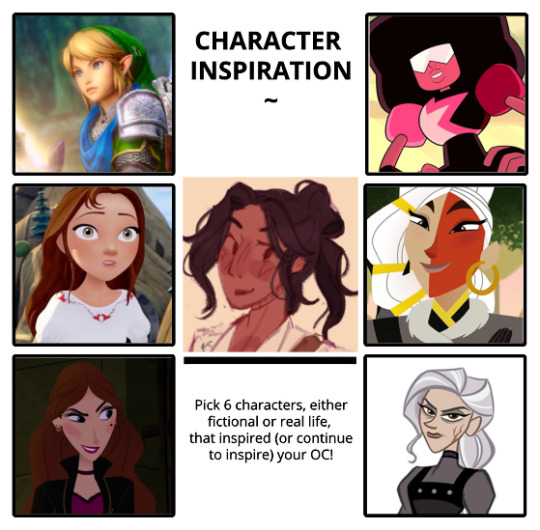
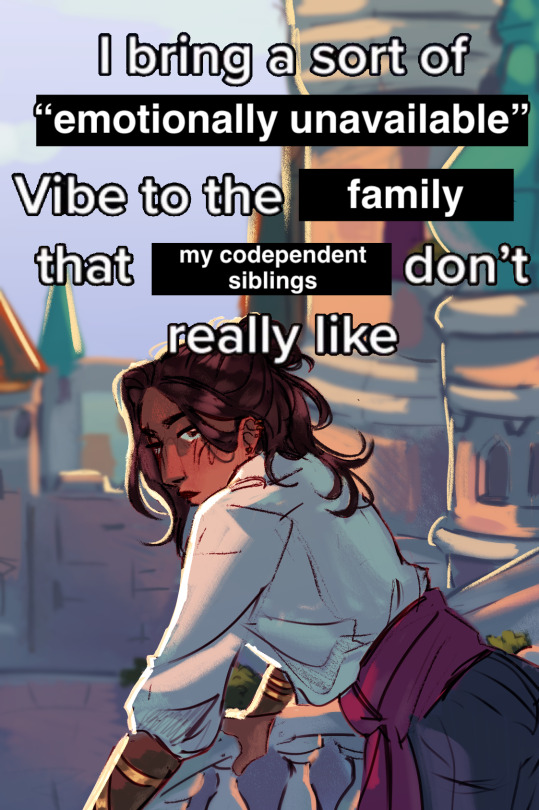
ILMARI!! ILMARI MY BABYGIRL!!!!!! Ilmaris honestly so so SO bad at feelings they are so distant but i swear they TRY THEIR BEST they just have AUTISM 😭🙏Unlike the twins ilmari doesn’t really have a huge change in character LOL…But i need to talk more about the trios dynamic, cuz they’re all VERY close especially when they were little. Once ilmaris traveling on their own, though, their relationship is a little more strained……..like i said ilmari is very much a wanderer, and they don’t write much either. Obviously they send like monthly letters to ukd out of obligation (cass and eugene especially get CRAZY paranoid otherwise…..) as well as some gifts to the family whenever they can but. Their letters highkey read like business emails LOL.
Ilmaris in a weird place where they do truly care about their family but like….They still feel a big disconnect from their identity and relationships in general. The emotional neglect from their birth mother and the autism have mixed together in the worst way possible and emotions are just never something they really Get.
I think especially in early adulthood they dont really have anywhere where they truly feel like they belong- So they kinda just fuck off to do whatever. They don’t see much of a need to communicate with anyone, mostly cuz i dont think it clicks in their head that people might Want to know about that stuff GAHAHAHAAHA
this is hard on ukd and the twins who end up feeling like mari just…. slips in and out of their lives so easily 💔 DO NOT FRET THOUGH!!!!! They do visit and they improve at communicating over time….their letters are still Corporate email core but they’re more frequent at least. And they eventually come back to corona for good to take over the library when var and hugo retire
Uhhhh I think thats it for rn this is kind of just me screaming incoherently but this ask has made me start working on a new art post abt the ukd kids FOR THE MASSES. 🤞🤞🤞🤞 i need you guys to understand my autistic brainwaves. Heres some incorrect quotes i did with them also cuz they’re sillyyyyyy

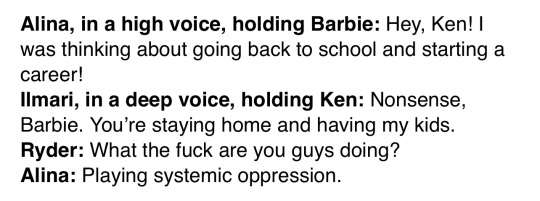



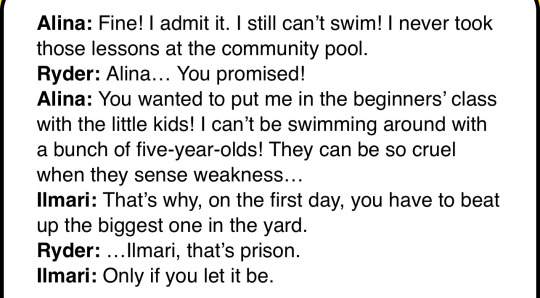
#tangled the series#rapunzels tangled adventure#tangled kids#alina#ryder#ilmari#pansy rambling again#tts headcanons#uknighted dream#unknighted dream#ukd kids#tangled ask#ask
29 notes
·
View notes
Text
Ok, Childe as a wuxia/xianxia trope. It's honestly a bit embarrassing how well this fits.
(blame @a-yarn-of-purple-prose for this post and if anyone here is a wuxia fan feel free to correct me, I'm new to the genre)
Wuxia is a Chinese martial arts fantasy genre you are all familiar with. An adjacent genre is called xianxia, "immortal heroes", it ramps all the fantasy elements up to eleven and skews tropes a bit (we'll get back to that).
A common trope is some kind of unorthodox school/sect or technique, allowing to achieve greater power without the usual decades of training. It could be straight-out evil or just revolving around chaos.
Such a martial school is usually called an evil/demonic sect (sect is more like a clan in that setting, not the modern concept of sect) and their techniques tend to drive practitioners to insanity. Either because they are inherently corrupting or because getting too much power without growing as a person is really not the best thing for your mental health. They are also often cast from hp points.
And then there's the archetype of a demonic sect heir. The best pupil or simply someone who has inherited a lost art. Proud, always greedy for more strength, often noble in some weird way.
*points to our calamity of a boy*
Common elements of such stories include:
Falling into some weird realm or meeting a weird person who teaches the hero a Forbidden Technique
Learning a technique too quickly through some sort of magic/alchemy/memory manipulation
Some people are so singular in their pursuit they become insane (走火入魔)
Ambition bad, loyalty and family good
Conflicting loyalties, generally a conflict between a chosen path and personal weaknesses/attachments (could be both ego and familal love, and this is more of a xianxia trope)
Fits like a horoscope so far but wait.
There's a very interesting case of Korean murim genre (their version of wuxia) where sects are less varied (I recommend this post for a basic introduction) and we get three paths:
Justice/Righteous/Orthodox/Light — theoretically they keep the Evil Faction at bay, and protect innocent people, but usually are corrupt to the core
Evil/Unorthodox/Dark — these try gaining as much power as possible and attempt ruling the whole world
Demonic Cult — usually dont take part in evil and justice battles, follow their own code of conduct based on their religion, value strength above all else.
(I'm sure there's a similar distinction in wuxia too, I just can't find it in the deluge of lore)
"Demonic" is closer to "pagan" or "heathen" than Christian idea of demonic here, their beliefs are often based on Zoroastrianism and worshipping a sacred flame. Do you remember all the Persian themes used for Khaenri'ah? And Surtalogi being the flame on Surtr's sword in Norse mythology. I also had the impression that Genshin gnostic references are based on the Zoroastrian-flavoured branch of Gnosticism.
In murim the trope of demonic sect heir is called "heavenly demon" (I believe, a more correct translation would be "supreme heathen"), they are utterly badass, live for the glory of battle, seem more like forces of nature and follow a very strict honour code often conflicting with normal human ethics.
(do I need to spell it out)
TvTropes also says this about Korean stories:
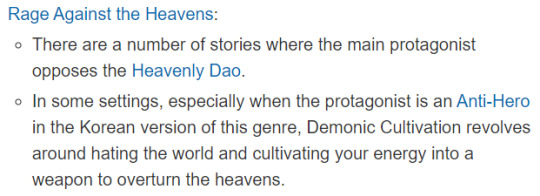
(do I need to spell it out pt.2)
I'm not sure why a Chinese studio would focus on the Korean version of this trope but I'm sure something like this exists in China as well or maybe there's a popular manhwa that inspired authors.
Xianxia extends the fantastic element further, focusing on Taoist concepts and practices and adding all kinds of magical realms (celestial, demonic, etc) and magical beings and making immortality achievable. I still need to read more about it but if I understand that right, demonic heir trope turns into a demon prince in this case. An actual visitor from the demon realm or a practitioner who achieved immortality through dubious means.
These are fae-coded in a way very similar to Childe and have a certain nonchalance towards things most humans would consider traumatic. They are simply not bothered by them, having a different set of morals or faring from a realm that is much worse.
Our boy isn't that (he's still very much human) but he's aesthetically coded like one, same as Scaramouche is yokai-coded, despite not being a yokai.
So. When people say Childe's arc is a reference to Journey to the West, it's not entirely untrue, JttW is the classic of xianxia genre and Childe does belong to the same genre. He, however, is not Sun Wukong but a different, darker trope.
This also explains why he has that "shonen anime protag but not quite" vibe. Shonen was heavily influenced by wuxia but this trope never quite made it to anime or maybe never became popular enough. It's not a deconstruction, it's a different story. Or perhaps a deconstruction of that different story.
#childe#tartaglia#wuxia#my investigation into what the hell this boy is is concluded#this means I'll get to think about something else#many thanks to saoki for indulging my questions for the past two days#there's also an argument for childe being a demon princess rather than a prince but I'm tired#maybe I'll get back to it if anyone wants to meme together#genshin lore tumour#skirk#khaenri'ah#if abyss be thy name I pledge to you my loyalty#I'll need another post to explain how it fits into some scenes#this is already too long
116 notes
·
View notes
Text
Im such a SUCKER for the characterization of Dungeon Meshi. Ryoko Kui and her editor Hiroi Masaru are incredibly great at subverting character tropes and archetypes with a perfect balance of strengths and weakness.
LAIOS to a bystanding viewer could easily seem like a himbo. He’s strong, a little bigger than average with his BMI at 26, and capable at fighting, but his lack of social skills is a BIG weakness. The thing is, that doesn’t make him unintelligent. Whereas himbos are just handsome goofs, his autistic coding is written so maturely. Although he can’t pick up on social cues, what makes up for it is his knowledge on monsters. His book-smarts sets him apart from the himbo spectrum. Regarding his past as revealed by the Winged Lion, Laios is a fairly flawed man who has complex desires. He just happens to be incredibly appealing. I love Laios.
FALIN, admittedly can be seen as a beacon-of-hope-damsel-in-distress that centers the entire plot and conflict. But what deepens her character is the additional conflict and consequence of resurrecting her, turning her into a Chimera. Her time as a Chimera can place her as morally gray, since she’s not actively thinking on her own accord during the confrontation with Laios’, Toshiro’s and Kabru’s parties. (Should also mention that scene where she doesn’t care where she teleports the crew as long as they were safe, even if it meant at the cost of hurting others.) She may be a beacon of hope, but only to the main cast. During her childhood, she wasn’t praised and treated like a princess by everyone. Falin is a fairly beloved woman in need of saving AND stopping, for she is capable of many scary things.
MARCILLE, oh Marcille is my favorite subversion. So easily can she be seen as the clumsy fanservice nerdy lady who complains about every single thing. But no, she’s metal as all hell. First off, she may be clumsy as is established by Chilchuck, but thank god she’s not sexualized. No fanservice in SIGHT. The only attractive thing I see is her strength in magic. She’s incredibly smart but in a way that is not universally approved. Her ancient magic and selfish nature to resurrect Falin through whatever means makes her so mature and powerful. Plus, her complaints with eating monsters are pretty valid. They’re not out of childishness, and she eventually gets used to it anyway. She is so so so complex in nature. She’s a scary elf lady but also incredibly endearing towards the people she loves the most to the point she can’t EVER comprehend the idea of losing them. Marcille is the epitome of “whatever it takes.”
CHILCHUCK very carefully bypasses that “small but a million times older than you expected” trope in lots of shows/animes. Being a half-foot, he’s usually babied by Marcille and Senshi. Despite this, that man so blatantly acts his age as a father of three: he has a habit of drinking, cusses a lot, acts the most reasonable out of the party, and he’s overall just so.. questionable, considering that “other plans” joke he did about Toshiro towards his party. Despite all these flaws, Chilchuck is just trying to do his job. He’s quite knowledgeable and responsibly when it comes to his work and adventuring with party members. He just happens to be a divorcee father.
SENSHI surprised me the most. He’s set up to be such a knowledgeable father figure to the cast. He’s incredibly caring of the dungeon and the habitants, and he cares for the “young-ins” like a good father should. He could easily pass with that trope, it’s not a bad one, but they decided to dig him deeper with his traumatic past. I’ve read another’s blog that describes him as just another kid at heart who is happy to have friends and it wrecks me. He may act overprotective and help guide the others, but he certainly doesn’t knowing EVERYTHING. Senshi is a man with the sincere intentions of protecting his friends, he just has a misguided sense.
IZUTSUMI I’m sure has been covered already by someone on here but she incredibly stomps away from the catgirl stereotypes of acting cute and cuddly. She’s aggressive, mean and loud. Only time she acts kitty-like is subtly— she likes sleeping on top of Chilchuck. Besides, she doesn’t really want to be a beastman. It’s her whole arc. You would have expected so much fanservice from her if this was a completely different show. Thank god, that’s not the case. Izutsumi is just a kid who knows what she wants albeit not gently, but she’s still a caring individual who is in the journey of exploring her freedom.
And KABRU is a funny case. His first introduction has a beautiful way of setting him up as a perfect leader, y’know, just that average “I’m effortlessly strong and witted and will rid of all evil” trope. Reality is poor Kabru lacks experience. He may have perceptive abilities, but throughout the early parts of DunMeshi, his party is shown to be easily taken down by monsters. Regarding how he and Laios are meant to be each other’s foils, Kabru’s strong advantages come at the price of his lack of knowledge in monsters. He just HATES them. Social cues are his own special interest. Kabru has the valid motivations, he just unfortunately doesn’t have the power to execute them.
This is my own little love letter to Dungeon Meshi. I love the characters so much, and I wanted to give praise to its writing that I can easily tell came from love and care. If you’ve read this far, thank you for sticking around! I love rambling about this beautiful world. I’m sure I’ve missed a few facts here and there, so let me know what you all think!
#THANK YOU DUNMESHI FOR THE GREAT WRITING <3#i wrote this in the middle of the night dont mind me rambling#dungeon meshi#autism is autisming#delicious in dungeon#rambles#ramblings
37 notes
·
View notes
Text
Phenotyping the Stereotypical Anime Love Triangle
Something I've noticed over my years of watching anime is the existence of a specific kind of love triangle. One that pops up over and over again, often in some of the most popular shows of their respective eras. And the more I think about it, the more it feels like the skeleton key to really understand The Male Fantasy as it exists in otaku culture. This particular trope, repeated across so many different genres and decades, is a Rosetta stone for understanding how male anime writers approach female characters and why so many of them fall flat. Or maybe it's just a fun little pattern I've noticed that I'm trying to make into a bigger deal than it is. Either way, I need to rant about it for a second so it'll stop bugging me. So roll up your sleeves and let's do some literary science here.
First, we need to define what exactly I'm talking about. This isn't about every single love triangle, nor is it about harems or any romantic situation with more than three participants. No, the breed of love triangle we're discussing here involves one guy at the center, romantically pursued by or entangled with two specific kinds of female character archetypes. The guy in question is pretty versatile: he can be shy, a self-insert, brash and egotistical, edgy and emo, whatever the story needs him to be. But it's the girls fighting over him who matter. Put simply, this is a love triangle where the two female characters represent two competing philosophies of romantic happiness for the male lead. They aren't just fighting over the guy: they're designed around two specific, directly contrasting character archetypes that the guy must choose between as competing statements on what love should be. And everything about the girls- from personality to color design to even superpowers- is designed to emphasize that contrast.
So what are these two competing archetypes? Put simply: Hot and Cold.
HOT: The exciting girl. Probably a tsundere. Even if not, her personality is strong and overbearing. Her hair is red and most likely long. If this is a fantasy setting, she'll be some flavor of alien or superhero or magical warrior, something that sets her above common people. Her elemental power is, naturally, fire. This girl represents challenge and adventure for the male lead. She's someone who crashes into his normal life and upends it, shaking him out of complacency and inspiring to seize his destiny with two hands. If he chooses her, it symbolizes his willingness to reach for greatness and keep pushing himself to accomplish the impossible, proving himself worthy of being such an incredible girl's partner.
COLD: The shy, quiet girl. Her personality is usually sweet and caring, though sometimes she can be a deadpan kuudere instead. Her hair is blue and almost certainly in some kind of bob cut. Elemental power: ice. While the Hot girl is someone new who crashes into the male lead's life, Cold is near-guaranteed to be his childhood friend, someone who's known him for a very long time. She represents stability and domestic comfort. In contrast to Hot inspiring him to rise above him limits and become something greater, Cold accepts him as he is. She's the girl you don't have to change for, the girl who'll give you a long and happy life of simple contentment. By choosing her, the male lead shows he's able to see the happiness right in front of him and mature into a dependable partner.
Obviously, not every example of this trope fits all these parameters. There's plenty of variation in how many aspects of the Hot and Cold archetypes each girl fulfills. But if you look across anime history, you will find that a great deal of 1-guy-2-girl love triangles fall into this pattern to some extent. For just a few examples:
Darling in the Franxx- Zero Two and Ichigo. Probably the most prominent modern example.
Chivalry of a Failed Knight- Stella and Ikki. Go watch Trixie's video series on The Asterisk War for more info on them.
Re:Zero- Emilia and Rem. Obviously Emilia's a huge departure from the Hot archetype, but she fulfills the thematic purpose of someone Subaru must challenge himself to be worthy of.
Oshi no Ko- Kana and Akane. They swap the expected hair lengths, but the personalities are pretty spot on.
Waiting in the Summer- Ichika and Kanna. Never watched it so I may be wrong, but from what discussions I've seen, these two fit.
Shakugan no Shana- Shana and Kazumi. The show where I first started noticing how often this trope popped up.
Guilty Crown- Inori and Hare. Another case where Inori is much more a Cold archetype personality-wise but fulfills the narrative role of the Hot archetype.
Evangelion- Asuka and Rei. Kind of a funny example because they probably inspired a lot of future hot/cold love triangles, but they're also worst-case subversions of their respective archetypes that turn what they represent into something horrifying (What if the spunky foreign girl is actually a walking shell of trauma? What if the demure girl-next-door was actually just Your Mom?). Essay for another day, perhaps...
Blue Box- Chinatsu and Hina. Pretty textbook example of how this trope functions in a normal, grounded high-school setting with no magic or monsters or whatever.
Your Lie in April- Kaori and Tsubaki. See above.
Fate/Stay Night- Sort of an edge case with Saber and Rin both fulfilling the Hot archetype, while Sakura tackles the Cold archetype.
And finally, an honorable mention for Flip Flappers, which asks the question, "What if there was no guy and the girls were just in love with each other instead?"
It's worth saying at this point that I don't think this trope is inherently bad. Writing characters who represent two contrasting ideas or philosophies on how to live is a staple of literature across history. And I don't think all of these examples are bad either! If you've been around on this blog long enough, you know how much I adore the way Re:Zero handles Subaru's relationships with the girls around him. But the reason this trope bugs me so much is, well... have you noticed anything missing in this discussion of what these archetypes represent and what it means for the guy to choose one or the other?
Exactly: What about what the girls want? What are their desires? So often it feels like the girls in this kind of love triangle are written solely for their importance to the male lead, with little consideration for who they are as people. This trope can work, but only when everyone involved has dreams and personal goals beyond the triangle itself, things they want to accomplish that are bigger than who ends up smooching who at the end. And while the guy usually has bigger, more plot-relevant things going on, it's a bit of a coin toss whether or not the girls are allowed that same interiority. More often, they only exist for the sake of some dude's personal growth, denied the chance for the narrative to build something resonant out of their own circumstances and speak to their own experiences. Case in point: Akane being driven to attempted suicide by online harassment in Oshi no Ko mostly just existing as an excuse for her to fall in love with Aqua for saving her with no lingering impacts on her psyche or her relationship with the entertainment industry. Because why focus on how this traumatic turn of events affects her when her story only really matters in service to someone else's narrative?
The Hot/Cold love triangle exists for straight boys and men to explore their perspective on love. It gives male viewers a choice between the excitement of love as a constant adventure that challenges you to be better and the warmth of love as a stable commitment that accepts you as you are, and it tries to guide them toward the answer it believes it's best. But a relationship isn't something you can possess like an object. It's not a choice you can make on your own. It's a partnership between two people, each of whom matters equally in building a life together. And if stories like this fail to show men the importance of the woman's perspective? Then no matter which best girl wins, all girls lose.
PS: Surprise! Stealth advertisement for my webcomic, lol. I actually got the inspiration for Beyond the Sable Shore from thinking about this trope and wondering, "How could I write this kind of love triangle in a way that's actually compelling and meaningful and does justice to the female characters?" So if this discussion was interesting for you and you wanna see me grapple with this trope a little more, feel free to check it out!
#tabw#anime#the anime binge watcher#darling in the franxx#chivalry of a failed knight#rakudai kishi no cavalry#waiting in the summer#ano natsu de matteru#re:zero#re:zero kara hajimeru isekai seikatsu#your lie in april#shigatsu wa kimi no uso#blue box#ao no hako#oshi no ko#evangelion#neon genesis evangelion#shakugan no shana
25 notes
·
View notes
Text
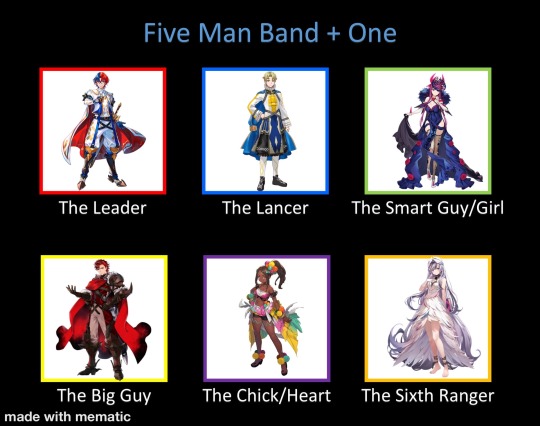
Have you ever noticed that Alear and the Four Royals acts as a Five Man Band? The story may not show that well, but their gameplay, nations and represented Emblems demonstrate that they are this trope perfectly. Veyle acts as the Sixth Ranger (actually 11th Hour Ranger). They best represent this trope as well because Alear, the Royals and Veyle are the only playable characters that can’t die on Classic Mode (oh and Vander too, but he’s just a mentor kind of guy).
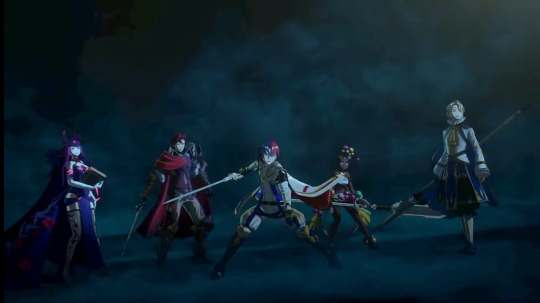
The Five Man Band is among one my favorite tropes in media. Why? IDK why, it just is. I used to be a Power Rangers fan, five is usually among the highest these teams get to. In which case it becomes a Three plus two scenario where a Power Trio becomes a Five Man Band (Ninja Storm, Dino Thunder, and Jungle Fury come to mind).
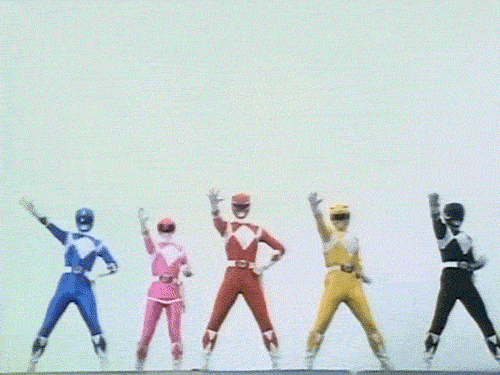
I bring up this trope to talk about Fire Emblem Engage specifically, Alear, and the Four Primary Royals fit this trope. And it’s not just in team composition, IMO, the Emblems they are best known for (specifically in the Prologue cutscene) best give idea on why they fit the role in the team.
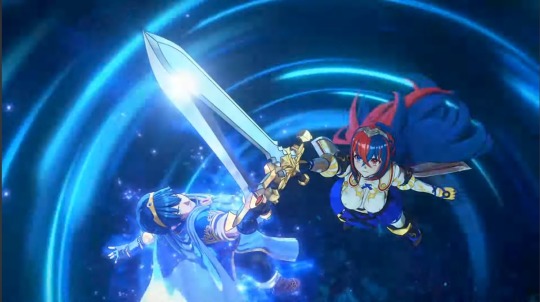
Alear the The Hero/Leader of the team; because obviously they are the Fire Emblem Lord, they are the Divine Dragon: the only one who can summon the Emblems who can save the world from the Fell Dragon. And just like any other Fire Emblem Lord in the franchise, if they are defeated, it’s a game over. Pretty typical Fire Emblem knowledge.
Alear’s most common Emblem is Marth. Marth is the first ever Fire Emblem Lord in the franchise, the idealistic leader that his loved ones trust and follows. Marth is the first of many sword wielding heroes in the franchise. Swords are a very common weapon type for heroes (Micaiah is the only Emblem in the main game that canonically never uses swords).
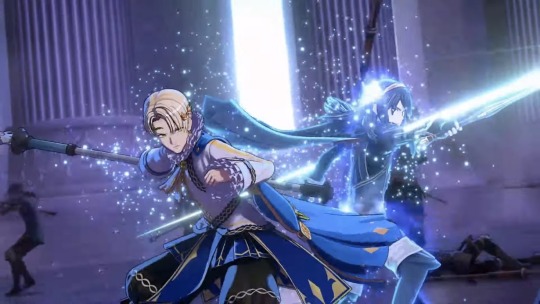
Alfred is the Lancer. Who usually acts a foil to the Hero/Leader, usually is their first/best friend/companion, and/or is the first to question any decision the leader/hero makes. Not every character of the archetype has to be a rival or a jerk (or in most cases both), Alfred is one of those examples. Alfred is the first Royal to join. Firene has the closest ties with Lumera, and Alfred appears in more cutscenes than any other Royal in the game. (Double points for having Lances as his primary weapon type).
The Emblem he uses in the Prologue is Lucina. Lucina is the not the central protagonist of Awakening, Chrom is. Even still, Lucina is a character who acts as an emotional foil to Chrom. More importantly, Lucina is the descendant of Marth, who happens to be Alear’s most associated Emblem.
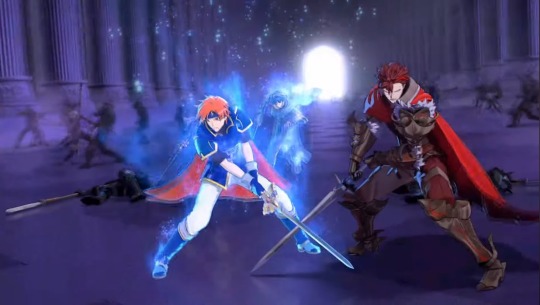
Diamant is the big guy/muscle of Alear’s team. Brodia is the Kingdom of Might after all. Diamant is the most physically imposing with his main stats being his HP, Strength and Defense. Diamant is also the tallest and oldest member of the team (age being 25, Alfred is 21, Ivy is 20, Timerra is 18 and Alear is physically 17).
Diamant’s national Emblem is Roy, who gives Sword Power as an inheritance skill that allows Diamant to hit harder with a sword, but at the cost of avoid. Rise Above (Emblem Roy’s Engage skill) increases his level and stats along with them. Ironically, Roy was 15 years old in his games, Diamant is the oldest Royal, yet Roy is one of the younger FE lords next to Leif.
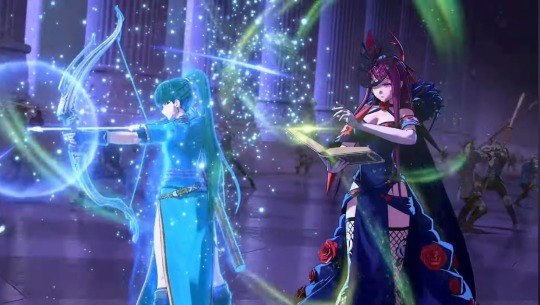
Next is Ivy, befitting of Elusia’s title of the Kingdom of Knowledge, she is the smart girl. Ivy has gone to school and was at the top of her class. (Studying is also one of her hobbies and likes items regarding them) Ivy is the most level headed of the Royals. Ivy is the only member of this main team that uses magic, and her ability to fly and heal is invaluable in a Fire Emblem game.
Ivy is associated with two Emblems rather than one. Lyn (the Emblem entrusted to Elusia) has the ability to summon doubles that can be used to distract the enemy. While Leif is an Emblem that switches between your current weapons it best suit the situation (often for the worst, unfortunately). It’s also worth noting that Soren is the DLC Emblem entrusted to Alt. Elusia. Soren is the Tactician of the Greil Mercenaries.
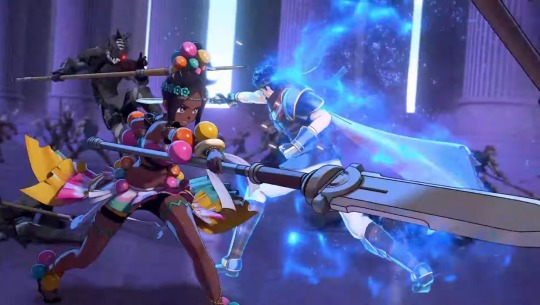
Finally, Timerra acts the emotional core to the team as the heart. Despite being far more politically savvy than what her peppy personality might suggest, she still is a genuine mood-maker in her supports where she attempts to get Ivy to open up and give perspective to Diamant on their ways of leading their countries. Her Queendom represents Freedom and is a very accepting person.
Her Emblem is Ike, and even if people mainly see him as a snarky guy, Ike is a very compassionate person. I mean, Ike would have to be a nice guy if he is the only person Soren is unfailingly kind to and is devoted to above everyone else. Ike’s Resolve (pun intended) is the thing that keeps the Greil Mercenaries from falling apart after his father’s death. Gameplay wise, Timerra with Ike act as a Critical Hit fighter with Wrath and Sandstorm. It takes a lot of effort and a bit of luck to make the most of her.
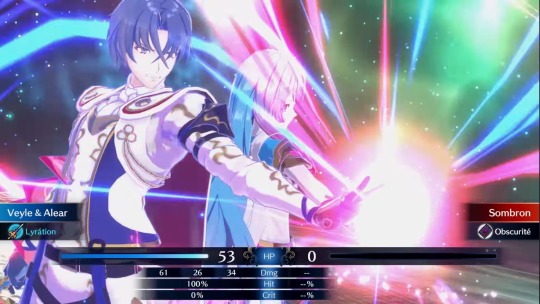
And finally, Veyle rounds out the team as the Sixth Ranger (doubles as 11th Hour Ranger, she is the last recruit in the main game). Sixth Rangers often comes joining in the team after a rivalry dispute and or brainwashing (Tommy Oliver (trope namer) and Zuko from Avatar comes to mind), Veyle is no exception. Veyle is the only other Non DLC Dragon units in the game. Most Sixth Rangers often (like the Red Ranger) have a power no other Ranger does.
Veyle doesn’t have a designated Emblem outside of Marth (who her evil self used, and she has boss dialogue with Emblem Marth in his Paralogue), but I consider Emblem Alear to be the closest thing Veyle will get to a designated Emblem. Her evil self also wears Alear’s Ring in the bad ending.

The major difference between Alear’s team, and the Four Hounds led by EVeyle is that the Hounds were already formed long before the story began. Alear and the Four Royals don’t officially form until more than halfway through Engage’s main story chapters. And yet these guys became a real team where the Hounds failed.
#five man band#tv tropes#tropes#writing#fire emblem engage#fire emblem#jrpg games#jrpg#alear fire emblem#fire emblem engage alear#emblems#fe alfred#diamant#roy fire emblem#ivy#timerra#fire emblem veyle#veyle fire emblem#veyle#fe veyle#Sixth Rangers#fe engage#fell xenologue#alear x nel#JRPG party members#character analysis#lucina#lyn#fe roy#fe ike
46 notes
·
View notes
Note
Hi Sugar!
I was reading your analysis of the five couples you see as endgame (this one here) and I really enjoyed it! But I was wondering; how do you think that Pyrrha plays a role in Jaune and Weiss's relationship? Is it something like Cinder or something unique, or maybe nothing at all?
Hi,
thank you so much for this ask! I really really love White Knight, so asks on its structure and thematic meaning are welcome!
So, Pyrrha is 100% important, as it is Ruby. They both are key for Weiss and Jaune's relationship. Of course, I am headcanoning WK is gonna be endgame. However, even if this isn't the case, I think many of the things below will still hold true in a platonic sense :)

TRIANGLES
Let's consider these two scenes:
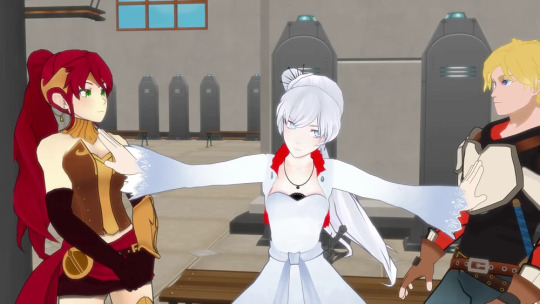

What do they have in common?
They focus on Weiss and Jaune
They involve a dynamic among three characters
They deal with the choice of a partner
Both Jaune and Weiss have a specific partner in mind. Jaune wants Weiss, while Weiss wants Pyrrha. However, the end results are different from what they expect. Weiss finds Ruby, while Jaune is chosen by Pyrrha.
Why is that so? It is a case of want vs need. Here is an extract from the above linked meta:
By this point Weiss and Jaune are pursuing a superficial dream of heroes and monsters. They figure their most perfected selves beside the "right" patner.
On the one hand Weiss wants Pyrrha to be the "knight" to her "princess":
Weiss: This will be perfect! The smartest girl in class combined with the strongest girl in class! Together we will be unstoppable!
She wants someone strong (body) that complements her intelligence (mind). She thinks that in this way she can't fail.
On the other hand Jaune wants Weiss to be the "princess" to his "knight":
Jaune: Don't worry! No need to be embarrassed! So, been hearing rumors about teams! I was thinking you and me would make a good one! What do you say?
He wants someone who is beautiful and looks frail, so he can protect her. He thinks in this way he can appear strong.
Both are wrong obviously. This is why they end up with respectively Ruby and Pyrrha as partners.
Weiss needs to realize what complements mind is not body, but heart. This is why she is paired with Ruby, who lacks physical strength, but has more than enough heart to guide Weiss. Throughout the initiation, Weiss herself has to act as a Knight by saving Ruby from the Nevermore. And later on, she needs to follow Ruby's plan (so Ruby's mind) to take down the Grimm and pass the trial.
Jaune needs to realize a real knight is not physically strong, but is wise (mind) and brave (heart). This is why he ends up with Pyrrha, who is both and challenges him in two different ways. She doesn't fit feminine stereotypes and sees Jaune's value not in his superficial traits, but rather in his willingness to help. Throughout the initiation, Jaune shows this by staying behind to lead others into kiling the Grimm.
In short, Jaune wants Weiss, but needs Pyrrha, while Weiss wants Pyrrha, but needs Ruby. Let's make two considerations:
1- WK is built on "triangles". A triangle is a trope where one character wants another, but this other wants a third person, who is instead interested in the first. This is obvious in Weiss, Jaune and Pyrrha's dynamic. Weiss wants Pyrrha, who wants Jaune, who wants Weiss. The song Dream Come True strengthens this idea, as Pyrrha sings to Jaune, while throwing shades at Weiss.
Obviously, the triangle is quickly solved. Weiss warms up to Ruby as her partner and Jaune gives up on Weiss and falls for Pyrrha.
Still, this early setting is important. As a matter of fact RWBY plays with romantic archetypes in its ships. Two examples:
Renora deconstructs and reconstructs the childhood friend to lover trope. Usually, there is a character, who falls first and supports the other, until their love is reciprocated. Here, though, Nora eventually realizes that to stay with Ren, she needs to grow as her own person. Both partners need to change, so that their dynamic can transform.
Bumbleby uses a harem to explore Blake's developing interiority and animus. Each one of Blake's love interests tie into her sexuality, inner maturity and fairy tale symbolism. By going through Blake's "harem", we get many different relationships that help Blake explore herself, until she is ready for Yang.
In short, RWBY gets inspiration from love tropes, but it makes them thematic. The same can be said about WK and triangles. The point isn't that W,J and P or W, J and R are in romantic triangles, but rather that these characters make 2 thematic trios. In other words, Pyrrha and Ruby foil Weiss and Jaune and are both important for their relationship. Similarly, Weiss and Jaune's bond is key for their respective dynamics with Ruby and Pyrrha.
2- Weiss and Jaune's want vs need struggle applies to more than just the choice of a partner. It actually defines their whole arcs.
Weiss wants to honor her family legacy, but needs to define herself outside the Schnees. Jaune wants to be a strong hero, but needs to love himself for who he is. That said, Weiss and Jaune will both realize their early want. Weiss is gonna define a new legacy for the Schnee Family. It is just that the SDC is no more a part of it. Jaune is gonna bloom into a hero. It is just that true heroes are not always the strongest. Both are getting their want, but in an unforeseen way.
The same holds true for their preferred partners. Weiss is getting Pyrrha (yes, really) and Jaune is getting Weiss. Confused? No worries, it will all be clear in a minute ;) For now, let's analyze both Whiterose and Arkos and what they mean for White Knight.
WHITEROSE - HUNTRESSES
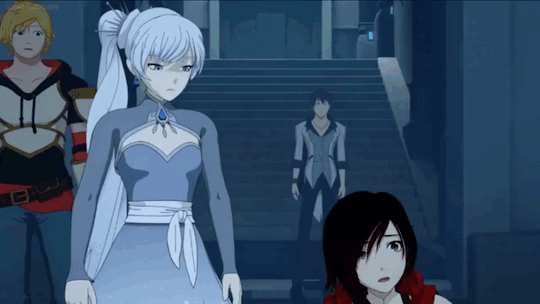
Weiss and Ruby are each other's "hunting" partners. They fight side by side to save lives and pursue the same dream of becoming Huntresses. This is the thematic heart of their relationship, which is mirrored in their intertwined allusions. As a matter of fact there is a Hunter in both Snowhite and Little Red Riding Hood.
On the one hand Snowhite's Hunter is weak. He wants to help Snowhite, but all he can do is not to kill the princess and to leave her alone in the woods. On the other hand Little Red Riding Hood's Hunter is the hero of the fairy tale. He kills the wolf and saves the protagonist and her grandmother. What does it mean for Whiterose?
It ties in how Ruby inspires Weiss. Let's consider this scene:
Ruby: Weiss! Go for its belly! There's no armor underneath...
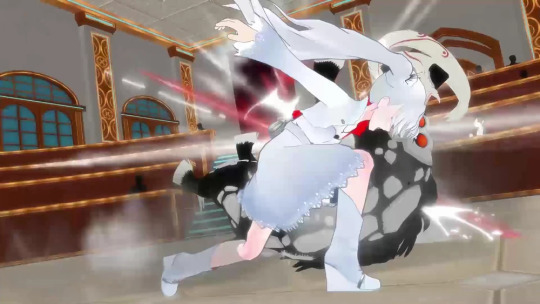
In the fairy tale, the Hunter kills a boar to help Snowhite. It is his one good deed. Similarly, Weiss kills a Boarbatusk with Ruby's help to act as a true Huntress. This is why the Grimm later on becomes an avatar symbolic of Weiss's Huntress side:
Port after Weiss kills the Boarbatusk: Bravo! Bra-vo! It appears we are indeed in the presence of a true Huntress-in-training!
Weiss in the aftermath of the party where she summons the Boarbatusk for the first time: The Schnee family legacy isn't yours to leave. It's mine, and I'll do it as a Huntress.
The metaphor is clear. Ruby (LRRH's Hunter) inspires Weiss (SW's Hunter) to grow into a hero. She leads Weiss towards a better version of herself:
Weiss: Just know that I am going to be the best teammate you'll ever have!
This is the perfect set-up for Weiss to eventually inspire Ruby back. For her to become the Huntress who saves Little Red Riding Hood:
Weiss: I don’t know who you think you are, but let me tell you who I am: I am the granddaughter of a hero and a child of a villain. I am a citizen of a fallen Kingdom and an heir to nothing. I will not be defined by my name because I will be the one to define it. I am Weiss Schnee, and I am a Huntress!
Past Ruby: So, are you a Huntress? Like the ones you read about in books? Ruby: I… I don’t know…
Volume 9 offers Weiss a perfect chance. Ruby is lost and is eventually eaten by two Big Bad Wolves (Neo and the Curious Cat). However, Weiss fails:
Ruby: Don’t worry. We’ll find a way outta here and we’ll go back home. Weiss? Weiss: It's… It’s all gone… There’s nothing left for me to go back to… Just like Beacon… Ruby: You did the best you could for Atlas, Weiss. Weiss: But it wasn't enough! We hatched a crazy plan that put a whole kingdom at risk, and we don't even know if we saved the Relics from… Maybe… Jaune and Winter were able to get them out, despite… everything… despite us…
Several times Ruby notices Weiss's pain and tries to comfort her. Several times Ruby is similarly struggling, but Weiss can't support her. Weiss herself explains why:
Weiss: Maybe she didn’t feel like she could… Ruby has always been the one to get us through the hard times. We say things like “We believe in you”, “We can count on you”. I know we mean well, but…
Weiss idealizes Ruby too much and downgrades herself. She thinks Ruby can lead them all, but Weiss has actually grown enough to guide others too. She shows it by helping Jaune:
Weiss: I think you’re asking too much of yourself. We’ve been telling ourselves that failing means we’re no good. But I can guarantee even the best Huntsmen in history… they’ve all lost. But they were still incredibly brave… and good.
Weiss's speech here is an inversion of her initial dialogue with Ruby. There she feels her best is not enough and she drowns in self-hate. Here, she realizes that even if she and her friends lose, they are still good people.
It is a game of mirrors. She fails to see Ruby because she can't help herself. She sees Jaune and saves herself by helping him.
In short, Weiss fails with Ruby, but succeeds with Jaune. I think this is key for Weiss, Ruby and Jaune's dynamic.
At Beacon, Weiss is too immature for Pyrrha and doesn't see Jaune as a romantic partner. She needs Ruby to grow as a person.
In the Ever After, Weiss depends on Ruby too much and needs Jaune (who is Pyrrha's legacy) to develop.
So, she grows with Ruby until she and Jaune are ready for each other. Now, her bond with Jaune is helping her to bloom in the friend Ruby needs. It is a virtuous cycle where both Ruby and Jaune help Weiss mature, so that she can be the best partner ever. Platonic for Ruby and romantic for Jaune (imo).
If this turns out true, then Weiss's Nevermore might be tied to both Ruby and Jaune (other than to her team and family).
It is already strongly associated with Ruby, as team RWBY killed the Grimm together. Moreover, Weiss first tries to summon it to save her partner:

Later on, she materializes its wings while fighting with her team minus Ruby:
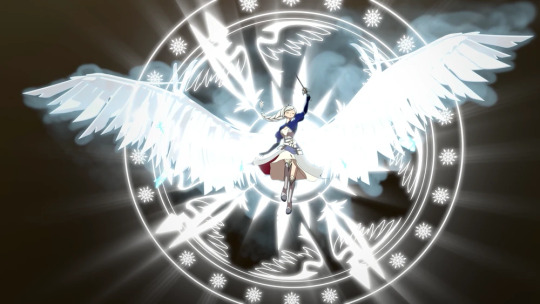
And eventually conjures the whole thing, as Ruby comes back:

It is possible the Nevetrmore will be linked to Jaune, as well. After all, he is the one who calls Weiss "Snow Angel". The Grimm is meant to show that Weiss can indeed be an angel to others:

Ruby and Jaune are equally important for Weiss. She needs Ruby to end up with Jaune and she needs Jaune to be the Huntress Ruby deserves. At the same time, Ruby and Jaune represent two sides of Pyrrha, the partner Weiss initially wants.
I usually don't use spinoffs, but I think Ice Queendom makes it pretty clear:
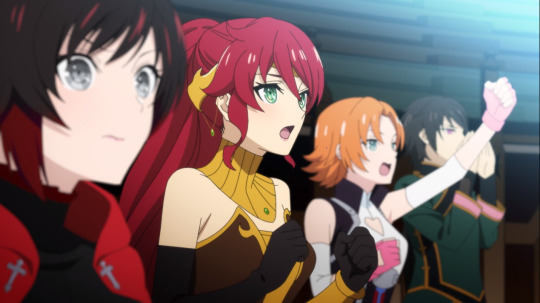
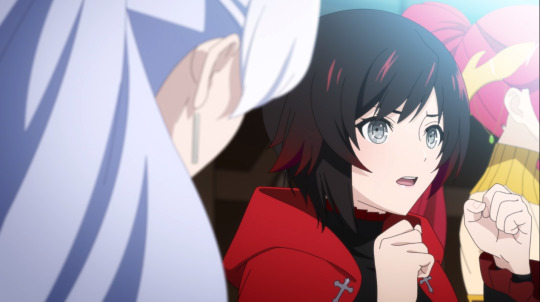
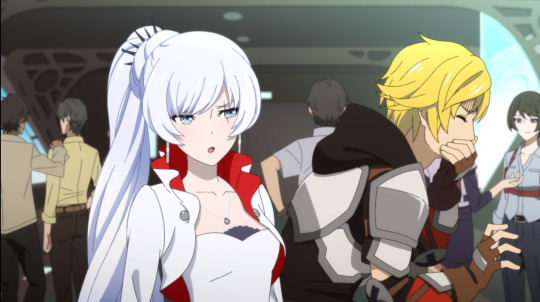

Weiss looks at Pyrrha in awe, but the ones she needs are Ruby and Jaune.
Ruby is a paragon, just like Pyrrha. She has both mind and heart, like our Achilles. The main difference is that Ruby is younger, so she lacks experience and fighting prowess. Weiss needs Ruby for 2 reasons:
She needs to reconcile with her inner-child that has been suppressed by Jacques's abuse:
Weiss: I always wanted bunk beds as a kid.
She needs to see what's important is the heart (Ruby's idealism) and not the body (Pyrrha's fighting skills).
What about Jaune? In which way is he Weiss's Pyrrha? Let's discover it.
ARKOS - ANIMA

Pyrrha is Jaune's partner and his love interest. She is also the key character of Jaune's story, as his allusion makes clear. Jeanne d'Arc is a maid whose actions are inspired by God. Similarly, Jaune is a knight able to perform miracles:
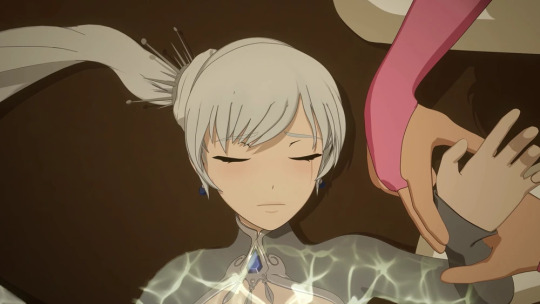
Whose hands and resolve are guided by his Goddess:
Jaune: No. I don't think I'm healing her. Our Aura heals our bodies. It feels… it feels more like I'm using my Aura to amplify hers! Nora: Wait, aren't you worried about running out? Jaune: Pyrrha once told me I've got a lot of it. I still believe her.
Pyrrha is Jaune's deity and inspiration:
Pyrrha: For it is in passing that we achieve immortality. Through this, we become a paragon of virtue and glory to rise above all. Infinite in distance and unbound by death, I release your soul, and by my shoulder, protect thee.
So, Jaune's arc is about:
becoming like Pyrrha
overcoming Pyrrha's death
Still, how can Jaune become like Pyrrha, while leaving her behind? Aren't these 2 objectives contradictory? Only superficially. What Jaune must do is to integrate with his anima. In Jungian Psychology, the anima is the feminine part of a man. It is a side, which is often suppressed, but that needs to come to light for the man to truly mature into a balanced person. A person, who can have positive and healthy romantic relationships.
This is the crux of Jaune's character. He is inspired by Jeanne because she is both maid and knight. Similarly, Jaune must transform into a knight, who is also a maiden. A hero who overcomes his toxic masculinity by accepting his feminine parts. The only way for him to succeed is to integrate with his anima, who is represented by Pyrrha. From the first meta linked:
Jaune's journey through the anima is well conveyed through 4 stages, which stand for archetypical female figures. Each one represents a different level of maturity:
Eve is the mother - The boy has no romantic attachment and sees the woman as a source of protection and nourishment
Helen is the seductress - The boy feels romantic attraction and sees the woman as a talented individual, but pays no attention to her spiritual or inner life
Mary is the virgin - The boy feels mature love and sees the woman as a paragon of virtue, but pays no attention to her negative traits
Sophia is wisdom - The boy is ready for a relationship with a woman as an equal partner and sees the feminine as a source of wisdom with no need to objectify the woman anymore
These phases describe Jaune's general approach to women and how it changes. He arrives at Beacon looking for a girlfriend because that is what a man should do, which in itself is a very childish behavior. Then he grows to see the girls around him as powerful individuals, but he can't go behind the surface. This is true for Weiss, but also for Pyrrha, whose struggles he ignores. After her death, Pyrrha becomes an ideal, but she isn't the only one. For example, Jaune believes Weiss and Ruby can save Pyrrha from Cinder and later on he keeps idealizing them. In volume 9, he learns to let go of his idealization and to see others as their own people. He is stepping into Sophia (wisdom).
Pyrrha is Jaune's anima in the sense she represents the feminine side Jaune needs to acquire. At the same time, the way Jaune's relationship with Pyrrha changes highlights the boy's maturation:
Eve > Jaune is nurtered and protected by Pyrrha to the point he even compares her to his mother:
Jaune: Bring it on, Ice Queen! I'll have you know that I have been told that I am a natural born leader! Weiss: By who? Your mother? Jaune: A-and Pyrrha! Pyrrha: Hello again!
He feels no attraction towards her.
Hellen > Jaune grows attracted to Pyrrha, but struggles to understand her interiority. For example, he is unable to see her feelings for him or to fully grasp her inner conflict about the Maiden powers:
Pyrrha: I don't know if I can do it. Jaune: Of course you can. The Pyrrha Nikos I know would never back down from a challenge. And if you really believe it's your destiny to save the world… you can't let anything stand in your way. Despite Jaune's intentions, this doesn't bring relief. Instead, Pyrrha looks absolutely shattered, covering her mouth as she begins to sob.
Mary > Jaune idealizes Pyrrha and sees her as a paragon of heroism and virtue. He tries to emulate her and to become a hero like her:
Jaune: I think… I think she knew she wasn't going to win. That she might not come out alive. But… she also knew she was the only one that could try. Ren: So she did. Nora: Maybe we should too. Jaune: Yeah, we should.
This idealization is heartwarming, but it's what's keeping Jaune stuck. He can never overcome Pyrrha's death if he transforms her into an idol. Not only that, but it is something Pyrrha herself would not have wanted:
Pyrrha: I've been blessed with incredible talents and opportunities. I'm constantly surrounded by love and praise, but when you're placed on a pedestal like that for so long, you become separated from the people that put you there in the first place. Everyone assumes I'm too good for them. That I'm on a level they simply can't attain. It's become impossible to form any sort of meaningful relationship with people. That's what I like about you. When we met, you didn't even know my name. You treated me just like anyone else. And thanks to you, I've made friendships that will last a lifetime. I guess, you're the kind of guy I wish I was here with. Someone who just saw me for me.
Pyrrha is drawn to Jaune because he is the only one who does not put her on a pedestal. However, after her death, this is what our Knight does to an extent. So, a good resolutioin would be for Jaune to see Pyrrha for who she is. A brave girl Jaune loves and who dies too soon. This is the only way Jaune can forgive both Pyrrha and himself. This is where Weiss (Sophia or Wisdom) steps in:
Curious Cat: I am talking about you, Wise Huntress.
Let's compare these 2 scenes:
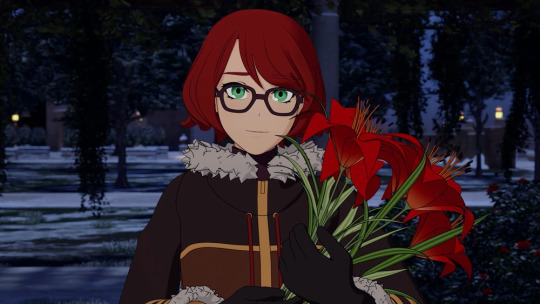
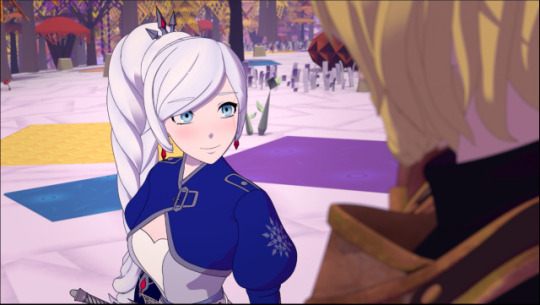
Both have Jaune struggling with grief and self-hate. In the first one, he has just lashed out at Oscar out of anger for Pyrrha's death. In the second one, he has just lashed out at Ruby out of anger for the paper pleasers ascending. Both times, he is doubting himself. Both times, a woman comes and reassures him. The first time, Pyrrha's mother/ghost/vision encourages him to keep going. The second time, Weiss encourages him to let go. Both scenes end with a family like re-union (team JNR and team RWBY).
Not to count there are mystical leaves flying around:

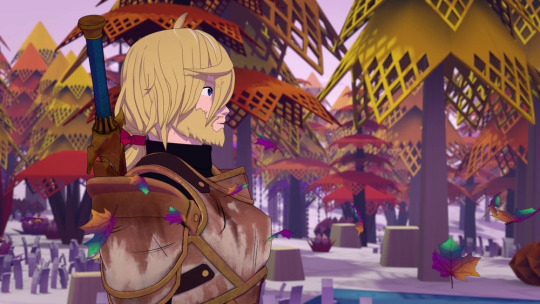
Someone coming back in an unexpected form:
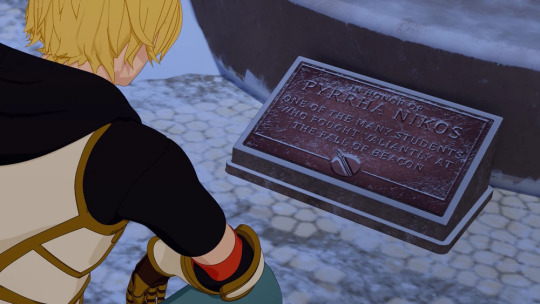

And a giant stone:


Both situations emphasize that even the best heroes fail. Still, they give this lesson a different spin. Pyrrha teaches Jaune the importance of going on despite the risk of failure. Weiss teaches Jaune the necessity of forgiving one-self for failure. Pyrrha acts as Mary and guides Jaune towards an ideal. Weiss acts as Sophia and leads Jaune towards his real self.
The final stage of the anima is about seeing one-self and the other clearly, both strengths and weaknesses. The romantic partner stops being objectified and is simply accepted as their own person. So, Jaune's final step towards self-actualization will be to let go of Pyrrha's idealized memory and to embrace Weiss, for whom she really is. This conclusion would be perfect for his bond with both girls:
Jaune would overcome Pyrrha's death by stopping his idealization of her. He would put Pyrrha down from her pedestal and love the girl in all her beauty and contradictions. He would finally be able to understand her fully, which is what he fails to do at Beacon.
Jaune would love Weiss for her true self, instead than her superficial beauty. He would appreciate the girl because she shares some of Pyrrha's best qualities, like her bravery and her heart, which is that of a Huntress. He would accept some of Weiss's most masculine traits, that he initially ignores.
In other words:
Jaune needs to mature by Pyrrha's side to be ready for Weiss
Jaune needs Weiss's help to face the memory of Pyrrha properly
As a matter of fact only by seeing Pyrrha clearly, Jaune can fully integrate with her, which means he can fully bloom into a hero like Pyrrha. Not only that, but he can succeed, where Pyrrha fails. What are Pyrrha's 2 objectives?
Pyrrha: I've always felt as though I was destined to become a Huntress - to protect the world
Nothing, even death Could separate our souls 'Cause you're my final goal
Pyrrha's 2 destinies are to be a hero and to be in love. She fulfills them both tragically. Jaune will fulfill them both in a more positive way.
He is guiding Cinder towards her destiny, by conveying the meaning of Pyrrha's words (heroism)
He is getting his happily ever after with Weiss (love)
In other words, Jaune is fulfilling Pyrrha's legacy thanks to Weiss and is ending up with Weiss thanks to Pyrrha.
THE BEAUTY OF WHITE KNIGHT
Let's summarize Weiss and Jaune's arcs.
Weiss's story is about overcoming her father's abuse. This starts with her affirming who she is outside her surname, goes on with her healing her family and it ends with a new legacy and a new romantic interest. The Schnee name is dirtied when Willow is caught in an abusive relationship with Jacques. Their marriage twists Weiss's perception of romantic relationships:
Weiss: All my life, boys have only cared about the perks of my last name.
So, it would be the cherry on top of Weiss's arc for her family to be reborn together with a new love. A bond with someone who genuinelly likes Weiss:
Jaune: It's Weiss. I'm completely head-over-heels for her, and she won't even give me a chance. She's cold, but she's also incredible. She's smart, and graceful, and talented. I mean, have you heard her sing? I-I just wish she's take me seriously, y'know? I wish I could tell her how I feel without messing it all up.
Jaune's story is about loving himself for who he is, as a whole. Strength and weakness. Masculine and feminine traits alike. The path to do so is to integrate with Pyrrha and become the hero she was. At the same time, he needs to work through his grief over Pyrrha's death. Both goals can be celebrated with the beginning of a fresh relationship. A bond with someone Jaune has always admired. That would be Pyrrha's final gift to him:
Pyrrha: Then do it. Tell her exactly what you said. No ridiculous schemes, no pick-up lines. Just… be honest. You can't get it wrong if it's the truth.
This is why I personally don't believe either Weiss or Jaune ending up single fits their stories. Weiss deserves a romantic partner who loves her, so she can write a story different from her parents'. Jaune needs a new relationship to give both himself and Pyrrha closure.
In conclusion, I personally think both Whiterose and Arkos are intertwined with White Knight.
Arkos especially is a part of White Knight. White Knight would not be possible without Arkos. At the same time, Arkos would lack a powerful catharsis without White Knight. They are 2 bonds that are bound to grow and develop thanks to each other.
Thank you for the ask! I hope my rambling made sense :)
#rwby#white knight#weiss schnee#jaune arc#pyrrha nikos#ruby rose#asksfullofsugar#milliethekitty27#rwby theory#rwby meta#i may be wrong of course#but here is why i fully support this ship#and in any case their relationship should get some focus :)#either romantically or platonically#it is intertwined with other important relationships after all#my meta
107 notes
·
View notes
Note
I remember you mentioning A court of Thorns and roses in your posts once when talking about malleus character archetype. Have you read acotar series? If so I really want to know what you think about it. Your post is how I found out this series. It's pretty meh 😕 to me but I would really like to read your thoughts on it 😊. Also are non twst related ask allowed? If not I'm truly sorry😥. You can just ignore this ask

Oh god 😅 That was such a long time ago that I can’t even locate the original post where I made that comment…
To summarize what I said then, I had expressed that the way Malleus is presented to us reminds me of the bad boy supernatural love interests in romantasy novels. I believe the online book community colloquially refers to these characters as “Shadow Daddies” and I find that hilarious. To clarify, I do NOT mean to say that Malleus is Yuu’s “canon” love interest or anything like that. When I say that Malleus is “like” a Shadow Daddy, it’s just in the tropes they share. (For example, being overpowered, brooding, and misunderstood as a “bad guy” when, in actuality, he has a heart of gold and is just lonely.)
… I’ve actually seen multiple posts comparing Malleus and Rhysand, if you can believe that 💀
The rest of my response isn’t really TWST related, so I’ll put it under the cut for ya ^^ I tried to keep my thoughts concise and free of spoilers.
But to your question! Yes, I actually have read the first three books of ACOTAR but not the novella (A Court of Frost and Starlight) or the sequel, A Court of Silver Flames. I got into the series because it was highly recommended within its genre, but I came out of it really disappointed. I continued reading hoping that it would get better, but it really did not.
Maas has this really melodramatic and yet simultaneously juvenile way of writing dialogue that does not mesh well with what I’m looking for in a romantasy read. She’ll have characters give exposition or speeches that go on for like 10 pages straight and also have supposedly wise ancient fae cracking potty jokes like a middle schooler trying to impress their friends. It makes the books a lot longer than they have to be. In actuality, the plot involves a lot of running around and having all the right questions answered by conveniently placed chess pieces. I also did not enjoy the vague world building (like several side characters are never given proper names and instead are always referred to by title) and the near-constant mention of mating bonds. What I did like was how Maas wrote action scenes and descriptions (even if they often veer into purple prose). She also comes up with some unique concepts—but the execution of those concepts isn’t great, so the ideas are left sort of shallow and floating there waiting to be fully realized.
Romantasy and fairy tale retellings are some of my favorite things to read, so I was sad that I didn’t think that highly of this beloved series. It’s been a while since I’ve read a book I’ve been able to seriously get immersed in 😔 ACOTAR’s explosive popularity has led to many other authors trying to replicate Maas’s success, which has flooded the market with horni fae books and even similar titles (“A [noun] of [nouns] and [nouns]”). (And as someone who does NOT find Malleus attractive at all, you can imagine I’m not thrilled.) I have really mixed feelings about that… While of course I don’t mind if people enjoy ACOTAR or ACOTAR-adjacent books, I dislike that it makes up the bulk of what is marketed to me. It makes it a lot harder to find something that’s more suited to my tastes.
If anyone seeing this post is interested in trying out ACOTAR, I caution you that it is a “new adult” book, meaning it is intended for older teens (I would recommend 18+, honestly). There is a lot of violence and… explicit intimate scenes… in the series.
#twisted wonderland#twst#Malleus Draconia#Rhysand#disney twisted wonderland#disney twst#notes from the writing raven#question#acotar#a court of thorns and roses
51 notes
·
View notes
Text
Danganronpa Despair Time Death Prediction (Chapter 2 Released Edition)

*This post was created when Chapter 2 Episode 15 is the latest episode released. I hope there's nothing at the end of this chapter that changes or crushes my predictions for now.
**Spoilers for Danganronpa Despair Time up until Chapter Two, if you're reading this for some reason then happy reading :3
Chapter 1 (Complete)
XXX
Chapter 2 (Complete)
XXX
Chapter 3 (Veronika kills Arturo and Whit)
I imagine because of her talent and unique personality Veronika will end up killing, although after chapter two I can see her being both a victim or blackened because of her secret revealing she 'harmed herself for fun'. I don't have any specific predictions on what she would plan because of her enthusiasm for horror. Might not be in character but I can imagine her making a 'treasure hunt' type presentation for her murders, collecting hints as to where the victims are, or revealing new cryptic information to the group. She could mess with lights, objects etc. in a different way than Min did because I can imagine her planning her crime in intense detail. Despite what I just wrote I hope she survives longer, I love hearing her enthusiasm towards character distress/aspects of the killing game but... I unfortunately can't see her making it to the end. I can imagine with her self harming tendencies she wouldn't mind being executed if she fails :/
I figure she would be smart enough to take out Arturo despite his height because he's the closest thing the cast has to a medical expert. Additionally I think she'd choose Whit to murder because of his smaller size/character archetype (jokester who doesn't take the killing game as seriously), and how it plays into her possibly favourite horror tropes. I could be dead wrong here but both Arturo and Whit seem like they won't really contribute story wise except for their family connections (Arturo's sister and Whit's mother, both of which I'm curious to learn more about). The creator has also confirmed it'll follow the original Danganronpa format, which is why I'm so confident there will be the typical two victims in chapter three regardless of who I guess.
Chapter 4 (Rose kills Hu)
This also mainly came about because of the chapter 2 trial. Unless I missed something up until now Hu seemed to take a 180 type character spin in a niche way, going from the motherly/helpful figure to still that but less so. She's now explicitly (and weirdly imo) delusional when it comes to understanding/connecting with people, using logic and arguing about her morals. With her angry outbursts at those she disagrees with and her newly revealed secret of 'trying to commit suicide three times' I think there's a very low chance she'll survive. She got fully taken advantage of by David and Niko since day 1 pretty much and will still try to be friends with Niko in chapter 3 I bet despite them literally attempting to frame her for their failed murder attempt. She wants to live so she claims but the odds seem to be against her now with the new group dynamic...
Rose I can also see being both a victim and a killer because of her random micronaps, complex memory with irrelevant memories and passive nature. If she is a victim she could leave a note with related to the most irrelevant clue of the case or use it to her advantage intentionally/unintentionally giving a false witness testimony in her trial (similar to Gonta in V3). She has also been betrayed by Nico (when they stole her turpentine so they could use it for murder), so it would be interesting for her and Hu to interact in more detail in the next chapter onwards. Her surviving to chapter four gives her enough time to come to terms with her memory and helpfulness or to have a different aspect of character development in my opinion.
I could see this murder playing out two ways. The first is that the two get in an argument over Nico, causing Hu to attack first. Rose then defends herself on the fly and thus a messily planned murder method and crime scene play out. The second is that Rose somewhat plans to murder for the sake of getting her family out of financial debt, and could use her art forging skills to make false evidence/visual confusion for her crime scene.
Chapter 5 (Nico kills Levi)
So chapter 5 is usually the chapter where characters take drastic action to end the killing game and/or it will be a very relevant to the final trial where the mastermind is usually exposed. Chapter 2 revealed that both Nico and Levi have alot of unlikeable personality traits that have now been brought to light. Both since the beginning of the killing game have also been social outcasts, and have had difficulty reading social cues. As both of them are murderers I would like to imagine in this scenario that to save the other contestants they have a Gundham/Nekomaru type dual. They've both murdered (or almost) before so neither would shy away given the right circumstances.
Survivors (Teruko, Eden, J, Charles, David)
I think this roster makes for a solid survivor group with an interesting range of personalities. I was originally planning to predict Teruko dying in chapter five because of the popular fan theory that her real secret is 'the killing game is all your fault' but if that's true it would make more sense to keep a consistent protagonist/the reveal would be more satisfying if you could see her reaction. None of the survivors (so far) seem to not be friends with each other so it would be interesting to see them work together to end the killing game, especially with Teruko being so distrusting of others.
David being this game's antagonist who can go either way for helping escape the killing game would be interesting to keep around story wise. Him, Charles and Teruko are three characters who contribute alot to each class trial, so I imagine it would be fun to see more late game bickering between them. And of course him getting blamed for things he didn't do because no one can trust what he says. Given how close he was to Xander it would make sense for him to be alive in order to solve all the mysteries surrounding him.
J while having an average intelligence as well as balance between emotional and logical responses would make for a good mediator between the rest of the survivors. She could also be very good for conveying the themes of fame and popularity because of her backstory (they're on live television which would be goof for ratings).
Eden is sort of the Himiko of this group surviving for the sake of her friends, and being the most devoted when deadly truths about the killing game are revealed (and man I want to know if she really used that fork to stab Xander's eye like alot of fan theories suggest).
I'm hoping and praying as a Charles fan that he and dead his brother who has been forgotten about are relevant enough to the plot for him to survive. In a final class trial as the ultimate chemist would be very useful for analysing and collecting evidence (as long as there is no more blood around which isn't very Danganronpa like haha).
20 notes
·
View notes